Tens of thousands of people descended on Washington DC for the Women's March on Washington, one day after President Donald Trump was sworn into office, marking one of the largest mass mobilizations after an inauguration in recent history. The organizers had originally applied for a permit for 200,000 people in DC, but now estimates have grown closer to 500,000 as of Saturday morning. More than 100 solidarity marches are taking place around the world, including an estimated 100,000 protestors in London.
The March Is On
Inside a Bus Full of Women Headed to DC for the Women's March
It's 3:26 AM on January 21, and I'm on a bus. With the exception of my dimly glowing laptop screen, it's completely dark, and most of my fellow passengers are resting up in preparation for the busy day ahead. My mother is asleep in the seat next to me, huddled under a fleece travel blanket, her head resting against the foggy window.
We're heading north on I-85 toward Washington, D.C. in a five-bus convoy that departed Greenville, South Carolina at 10:00 PM Friday night. We're on our way to the march.
Our group, which is sponsored by Greenville Democratic Women and the Greenville Democrat Party and includes nearly 300 demonstrators, will be meeting up with a couple hundred thousand others in just a few hours to join the Women's March on Washington.
Hydrodipping: The 'Redneck' Artform Taking YouTube by Storm
If you're an avid hunter or outdoorsman, you've almost assuredly seen guns, boots, antlers, skulls, and other paraphernalia coloured via this process. And even if you're not, you've still probably seen a few hydrodipping YouTube videos, some of which have millions of views.
"Hydrodipping is a rad effect, an ingenious way to print on a 3D surface," Pittsburgh-based illustrator Emily Traynor told me.
The process was developed by engineers in Japan during the early 1980s as a way of taking two-dimensional images from pieces of film and spreading them evenly across objects. The film, which had been gravure-printed with the image, is dissolved in the water. After the item getting hydrodripped is submerged, the image on the film curves around the item's surfaces.
Read more on Motherboard.
'Reproduction Basics,' Today's Comic by Анна Саруханова
A Courtroom Is a Crap Spot for a Coke Deal
In both news and popular culture, we often hear about the great lengths people go to when sneaking drugs into prison. Drugs are obviously big business behind bars, and getting around security is a puzzle that seems to inspire unlimited creativity.
Take, for example, the folks who hide micro-hits under postage stamps, or drop massive stashes via drone. And for those willing to endure a little discomfort, there's always the old fashioned up-the-anus technique.
On Friday, one Labrador man apparently decided to forego any spy-grade smuggle-craft in favour of a hidden-in-plain-view approach. Perhaps motivated by powdered courage or a fear of butt stuff, the 50-year-old dude was seen hand-delivering a baggie to a prisoner in a brightly-lit Happy Valley-Goose Bay courtroom.
It did not go well.
Read More: How Your Casual Drink and Drug Habit is Affecting Your Life Expectancy
Not deterred by sheriff's officers taking notice, this man allegedly decided to destroy evidence the fun way. According to the CBC, RCMP said they watched him not-so-discretely hoover a baggie of "suspected cocaine" before his arrest.
The man was taken to hospital, and then released back into RCMP custody. While probably feeling a lot less invincible today, he now faces obstruction of justice and trafficking charges.
Follow Sarah on Twitter.
The Absolute Best Signs from the Women's March
Hundreds of thousands of protestors have taken to the streets throughout US cities today, with nearly 500,000 estimated to be in attendance at the Women's March in Washington DC alone. And 100 more solidarity protests are taking place around the world. VICE News has rounded up some of the best signs from the protests thus far. Check out a sample below and go here for more.
Broadly Is Live at the Women's March on Washington
In our livestream, we talk with advocates fighting for women's rights, reproductive health, immigration, racial justice, Muslim rights, and LGBTQ equality among others to understand what rights we are already at risk of losing, as well as how we turn solidarity in the face of adversity today into a roadmap for justice tomorrow.
Canadians Say They're Getting Denied Entry at the US Border for Wanting to Protest Trump
There's a growing chorus of Canadians claiming they have been detained and turned away at the U.S. border for trying to attend the presidential inauguration and the Women's March on Washington.
Sasha Dyck, a 34-year-old from Montreal, told reporters yesterday that he and five other Canadians and two French nationals were denied entry at the St. Bernard de Lacolle border crossing into New York on Friday after explaining their protest plans to the American border guards.
He claims the group was told to go to secondary screening where they spent hours being searched, fingerprinted, and were told to unlock their cell phones for inspection.
"I hope it doesn't represent a closing down or a firming up of the border, or of mentalities south of the border," said Dyck, who added that he had no trouble getting through the border for Barack Obama's inauguration in 2009.
Read the rest on VICE News.
The Anti-Inauguration: Scenes from the Massive Women’s March on Washington
In his decades in Washington DC, Ranard Wood, 68, had never seen anything quite like what descended on the nation's capital on Saturday. That morning, a seemingly endless stream of people swarmed the streets surrounding the US Capitol, down the block from where he lives. The muddied National Mall was quickly filling with pink-puffed "pussyhat"-laden protesters. It wasn't even 10 AM, and there were already more people on hand than were there for Donald Trump's inauguration the day before.
Wood—who was holding a sign that read, "At the Midterms, Let's Get Real"—told me he wasn't surprised. "These people have been in power for six years, and they got nothing accomplished. Now, somehow, they're in charge," he said. "People are just fed up."
On Trump's first full day in office, the Women's March on Washington engulfed nearly every block within a one-mile radius of the Capitol. It was the largest demonstration an inaugural weekend has ever seen, and then some—early estimates of 200,000 to 300,000 were being revised upward by the end of the day.
The procession started at Independence Avenue and 3rd Street SW, where a stage was set for a long list of celebrity speakers and artists, from America Ferrera and Gloria Steinem to Madonna and Ashley Judd. On the streets, too, a slew of famous people were spotted, emblematic of the culture war that has been smoldering between Hollywood and Washington. There were even a handful of Democratic politicians and some scattered Trump supporters.

This had all started as a Facebook post that went viral and spawned a infrastructure of organizers; solidarity marches were held all around the country and internationally—even women in Antarctica showed their lack of support for Trump and his policies. The attendees were mostly women, but there were plenty of men, and they spanned all ages—kids, parents, grandparents—and races; a stark contrast to the more homogenous crowd that had welcomed Trump the day before. And their message was clear through one of their loudest chants: "Welcome to your first day! We will not go away!"
Even within 24 hours of taking office, Trump is already an unpopular president, and both his policies (for instance, his promise to defund Planned Parenthood) and his frankly sexist rhetoric have offended women in particular. Feminists are opposed to many of the principles of the Republican Party, but the fact that it's led by a man who bragged about grabbing pussy literally adds insult to injury.
The march wasn't simply about those issues, however, and you could find representations of anger at Trump's climate change denial and institutionalized corporate greed, among other causes. Some chants were a little more personal: "You're orange! You're gross! You lost the popular vote!"
As the crowds began marching towards the White House, I met Jordan Hemmerdinger, 12, and her mom, Jacquie, 43, who left New York City at 5 AM to be here. Every train station they passed was packed with people, they said, and even the conductors were welcoming the protesters to DC. "It was the perfect opportunity to get my daughters involved," Jacquie told me. "And to teach them that, when things don't go your way, you don't sit home. You have your voices heard."
I asked Jordan—who held a sign that read, "I'm a Feminist. What's Your Superpower?"—what it was like to be here. I told her that the day before, I had seen a number of children her age, wearing "Make America Great Again" hats, standing right where she was today. She said that on the morning after the election she told her mom that she was scared of riding the subway to school. "I was worried about people touching me," she said. "If it was normal for the president to be accused of sexual assault, won't it be OK for people to do it?"
On Friday, some anti-Trump protests became violent, but on Saturday the masses remained peaceful; throughout the day, there was little sign of confrontation with the DC Metropolitan Police, who closely monitored the march. As the numbers swelled, the original route was rendered useless, with blocks full of people with no cellphone service converging in every direction.
Nearly every protester I encountered was in awe of how many people had showed up here from all over the country (while most came from urban, traditionally liberal areas, I met women from Utah, Virginia, and Michigan), giving some reassurance that America hadn't totally lost its fucking mind. In the line for Don's Johns, the famed porta-potties that were still left over from the inauguration, I met a woman named Ann who worked in DC. She said that the subway ride in for her was more packed than any of her morning rush hour commutes. "We were concerned that enthusiasm would be down, after the inauguration and all," she told me. "Guess not."
When I asked her what the message of the day was, she shrugged. Then, she added, "I just know that Trump will downplay this as soon as possible"—indeed, the administration has already disputed the media's reporting on his inauguration crowd sizes. "But it's good that we all see each other here, and know we're on the same page," she continued. "Because this is not normal."
Follow John Surico on Twitter.
Follow photographer Jason Bergman on Instagram.
Some of the Best Signs from the Women's March in London
Protesters from across the world marched against Donald Trump in London Saturday, in solidarity with the Woman's March in Washington DC and other cities across the US and Europe. An estimated 100,000 people turned up to march from the US embassy to Trafalgar Square, where a number of speakers—including Labour MP Stella Creasy, actress Rebecca Hall, and broadcaster Sandi Toksvig—addressed the crowds.
On their way there marchers chanted "Build bridges not walls" and waved placards bearing messages about equality and the threat a Trump presidency poses to it. Photographer Chloe Orefice was there to take photos of some of those signs.

















All the Laws and Executive Orders Trump Has Signed So Far
This post will be continuously updated throughout 2017 as President Donald Trump signs executive orders and makes bills into laws. Read more about this project here.
January 20
Executive Order 1 : Minimizing the economic burden of the Patient Protection and Affordable Care Act pending repeal
What It Will Do: Trump's first executive order was a bold move to gut Obamacare in broad yet vague ways. The brief order empowers all relevant federal agencies to "waive, defer, grant exemptions from, or delay" the enforcement of key rules under their jurisdiction relating to the Affordable Care Act that those agencies believe impose financial or regulatory burdens on them or individuals. It also directs agencies to encourage a "free and open market in interstate commerce" when it comes to insurance and care, and provide as much flexibility to individual states as possible.
Who It Will Affect: The order is vaguely worded, and a lot of Obamacare's requirements are written into law, which a president can't simply change at will. But some observers speculated that it could lead to less enforcement of the mandate for everyone to buy insurance—if fewer healthy people buy insurance, the markets for insurance could become less stable.
For More: Read about what the end of Obamacare could mean for you.
Senate Bill 81 : A bill to provide for an exception to a limitation against appointment of persons as Secretary of Defense within seven years of relief from active duty as a regular commissioned officer of the Armed Forces
What It Will Do: The first law Trump signed as president just does what it says on the tin. Trump had nominated retired General James "Mad Dog" Mattis as his secretary of defense, but Mattis had he only left the Marine Corps in 2013—by law, members of the military have to be seven years removed from service before they can become secretary of defense. So Congress waived the requirement, just this once, and voila.
Who It Will Affect: This means Mattis will join Trump's cabinet—he was confirmed, nearly unanimously, by the Senate the same day the president signed this bill. Mattis disagrees with Trump on a lot of issues, and some are hoping he'll be a check on Trump's impulses.
For More: Watch the VICE News Tonight video about Mattis's nomination.
Proclamation 1: Declaring a National Day of Patriotism
What It Will Do: Although Congress has to pass a bill to create a new federal holiday, the president can unilaterally proclaim a day to be special for whatever reason—last year, Barack Obama declared several days of prayer and remembrance in honor of the 15th anniversary of 9/11. It's not clear when this day will be.
Who It Will Affect: You won't get the day off of work, but you can be patriotic on this day, whenever it is, if you like.
For More: Read about Trump's first few hours of document signing.
Australian Uni Students Are Taking a Seriously Long Time to Complete Their Degrees
In an era of high youth high unemployment and crippling anxiety about the future, the cocoon of tertiary education feels relatively warm compared to the cold, bleak life of a graduate seeking full-time work. This is perhaps why, according to new data released on Wednesday, Australian students are taking a really long time to finish their degrees. In fact, a third of them aren't completing their undergraduate studies within six years. Technically, you could complete the requirements for most bachelor's degrees in half that time.
According to the cohort study of completion rates for domestic bachelor students, only 45 percent of domestic bachelor students are finishing up their degrees within four years. The majority are taking longer than that. But there are some interesting details behind those broad figures.
Those who study externally (e.g. via online courses), people admitted to university through an avenue other than high school, and older students are all likely to have lower completion rates. As are students from lower socio-economic, regional, or Indigenous backgrounds. There's also a lot of variation in completion rates between institutions. Students at the University of Melbourne had the highest course completion rate, at 88 percent. Meanwhile only 42 percent of students at Charles Darwin University were donning the cap and gown within six years.
The simplistic reading of all of this paints Australian uni students as lazy drop outs—students taking six years to complete their BA and costing the government too much money. Many news reports were quick to emphasise that the national HELP loan debt stands at $52.5 billion.
It's worth noting though that there's a crucial difference between taking a while to find your passion and dropping out of uni altogether. Australian uni students may be taking a while to finish their degrees—frequently switching courses and taking time off—but they are still graduating at a high rate of around 82 percent.
This is well ahead of the OECD average of 70 percent. We actually rank third in the OECD for university completion, behind Japan and Turkey. So, Australia's slacker students actually still stack up well against the rest of the world. Our OECD results also compare favourably to nations with similar tertiary education systems. New Zealand students have a 66 percent completion rate, and the United States is around 64 percent.
Despite all this, Australia's completion rates still have the Federal Government pretty worried. With main round university offers being distributed this week, Education Minister Simon Birmingham is encouraging prospective uni students to "make the right choice, first time" to avoid bouncing between different courses and delaying their graduation date.
"We've heard too many stories about students who have changed courses, dropped out because they made the wrong choices about what to study, students who didn't realise there were other entry pathways or who started a course with next to no idea of what they were signing themselves up for," he said in a statement released alongside the new statistics.
Follow Kat on Twitter
I Got Rid of Tipping at My Restaurant to Fight Racism, Sexism, and Unlivable Wages
Making fun food is not enough; it's not nearly enough. I love all the things I create, I love the platform I have just as a chef, but that's not enough to make me feel good at night. [L'Oca d'Oro co-owner Adam Orman] and I both feel this is a platform of responsibility within an industry where there are systemic problems, like tipping.
Tipping is one of the tools by which discrimination is allowed to exist. I've seen the implicit racism that tipping leads to. Tipping started right after the end of slavery. It's basically a tool to keep control over people, to keep control over indentured servitude. Then you carry that 100 years further and you think about gender expectations and what one needs to do for a tip. In certain places, women have to exhibit a certain behavior and sell a certain something in order to get more tips, in order to survive in that atmosphere—and that sucks.
Read more at Munchies.
'Postal,' Today's Comic by Brian Blomerth
Gorgeous Photographs from the Women's March on Washington
Our buses from Congregation Beth Simchat Torah (the world's largest LGBTQ synagogue) were literally in a fog from New York all the way to DC. On the bus, people shared personal stories of previous marches and actions for social justice and why they were making this trip to the Women's March on Washington. Then we arrived at the headquarters of the American Federation of Teachers, and were soon immersed in a sea of people walking purposely through the fog. The designated route overflowed to all the surrounding streets. The Washington Mall, originally off-limits to the marchers, was filled.
Handcrafted signs of our times were everywhere. Creative, biting, and humorous—people from all walks of life wanted the urgency of their concerns to be seen and heard. Bright pink "pussy cat" hats were everywhere; groupings were identifiable by their distinct yarn colors, textures, and patterns. If you couldn't get into the speakers' area, it didn't matter—an amazing energy was everywhere. Cheers and whoops resounded through the crowds.
I noticed a small group on the edge of a grassy area away from all the crowds. These were the "Bikers for Trump," about two dozen of them, hanging around a musician doing cover tunes on a stage. At one point the bikers chanted "USA! USA!" in response to the marchers reprise of, "This is what democracy looks like!"
Going up Pennsylvania Avenue, the marchers got louder and angrier as we passed the heavily guarded Trump International Hotel. Further on, I spotted three young men wearing Trump hats; I photographed them and we wished each other a good day. I could have stayed all day, the crowd seemed endless, but it was time to catch the bus. Everyone on the ride back was delighted and energized by our efforts in Washington, and by news of the millions who attended the 673 sister marches all over the world. This is a start.
See Meryl Meisler's photos below.

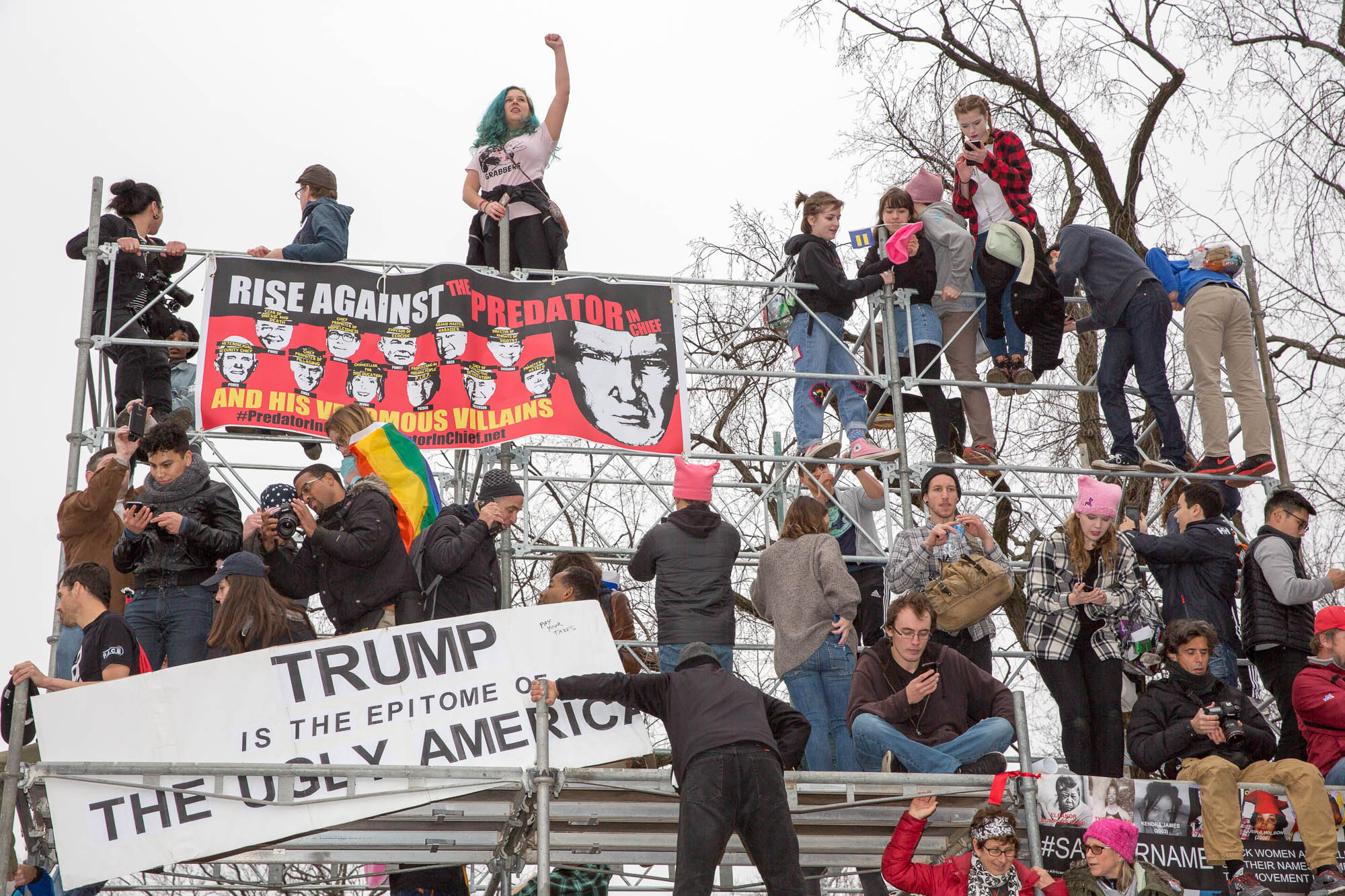
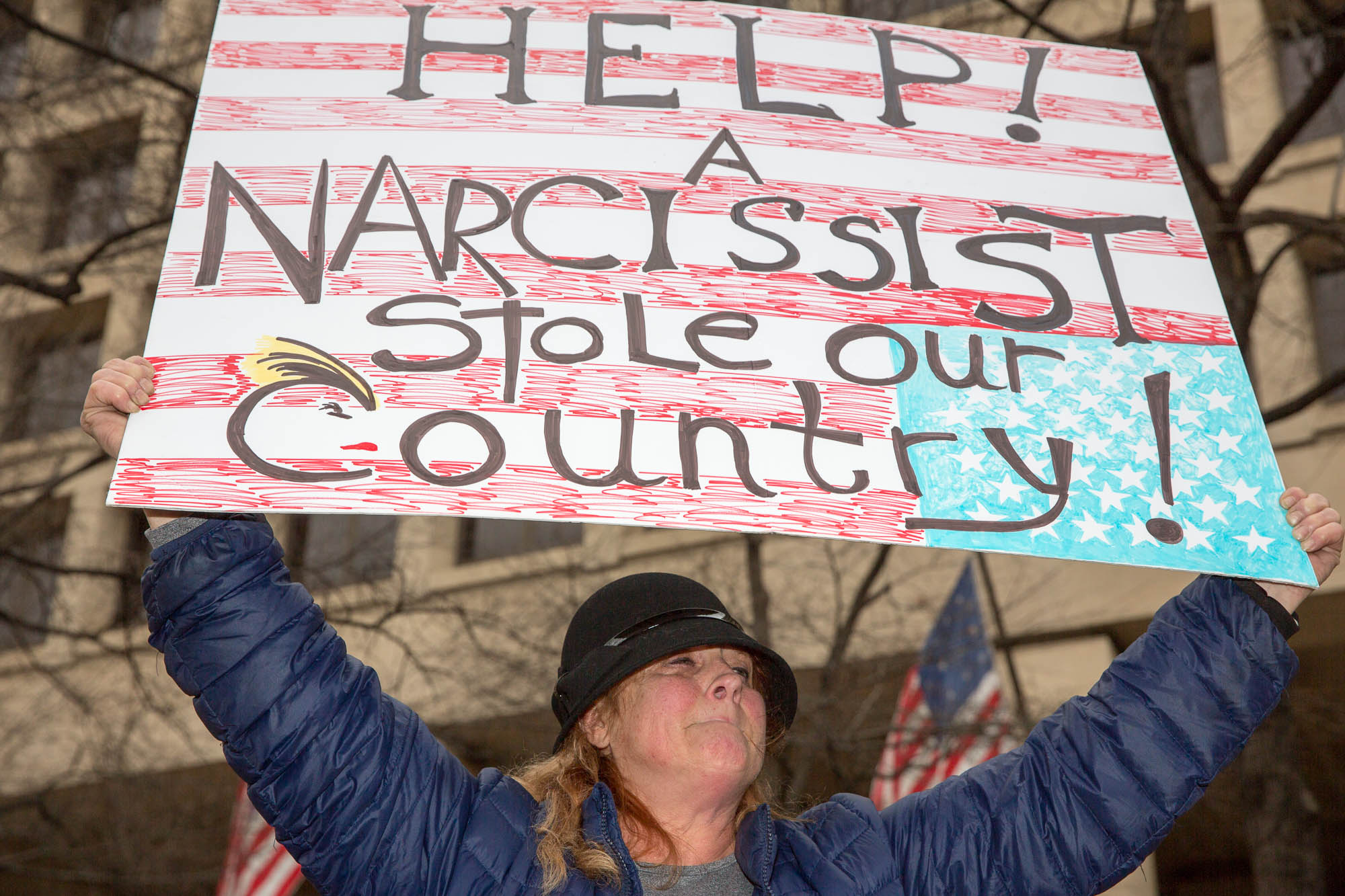
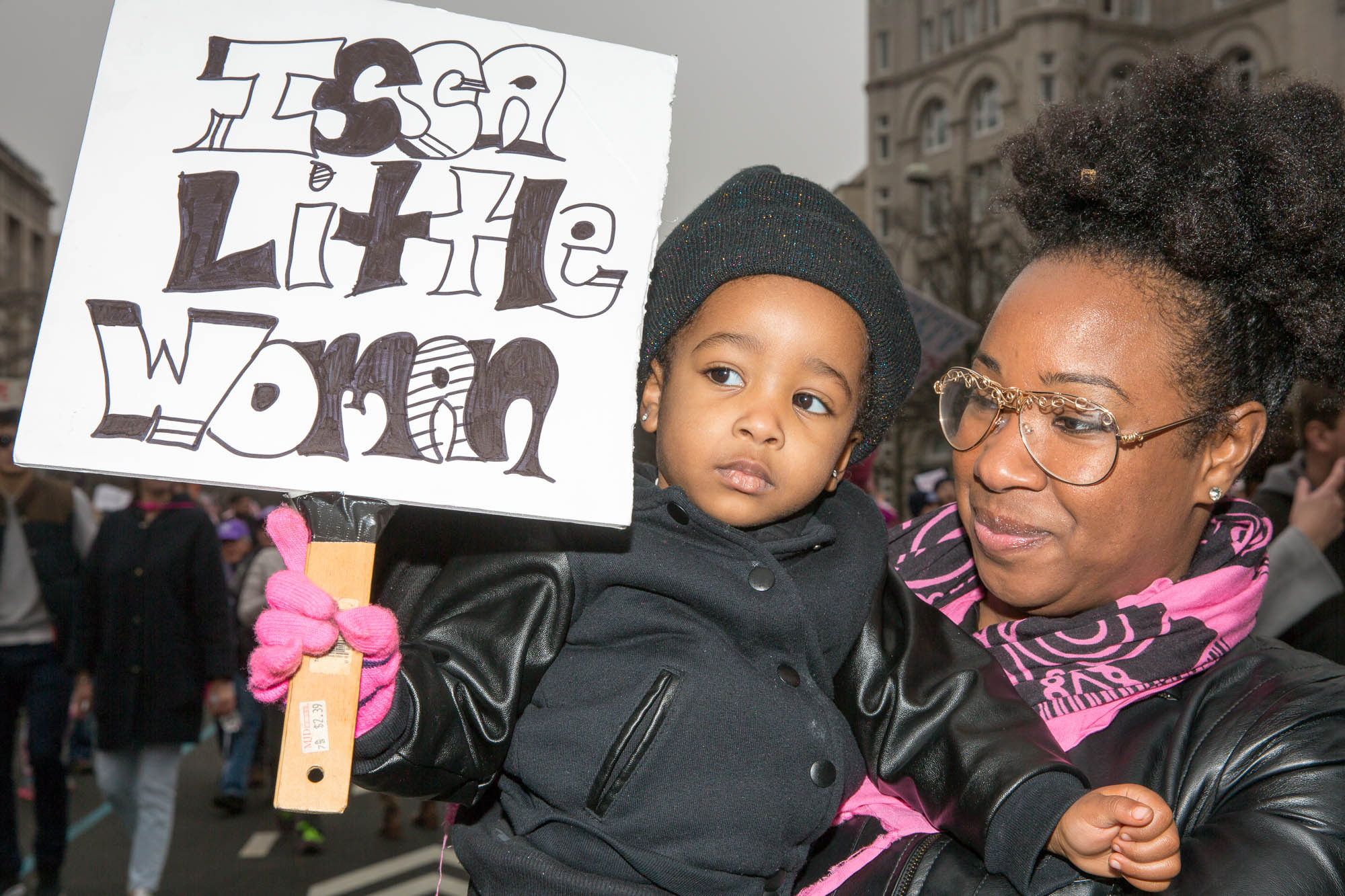
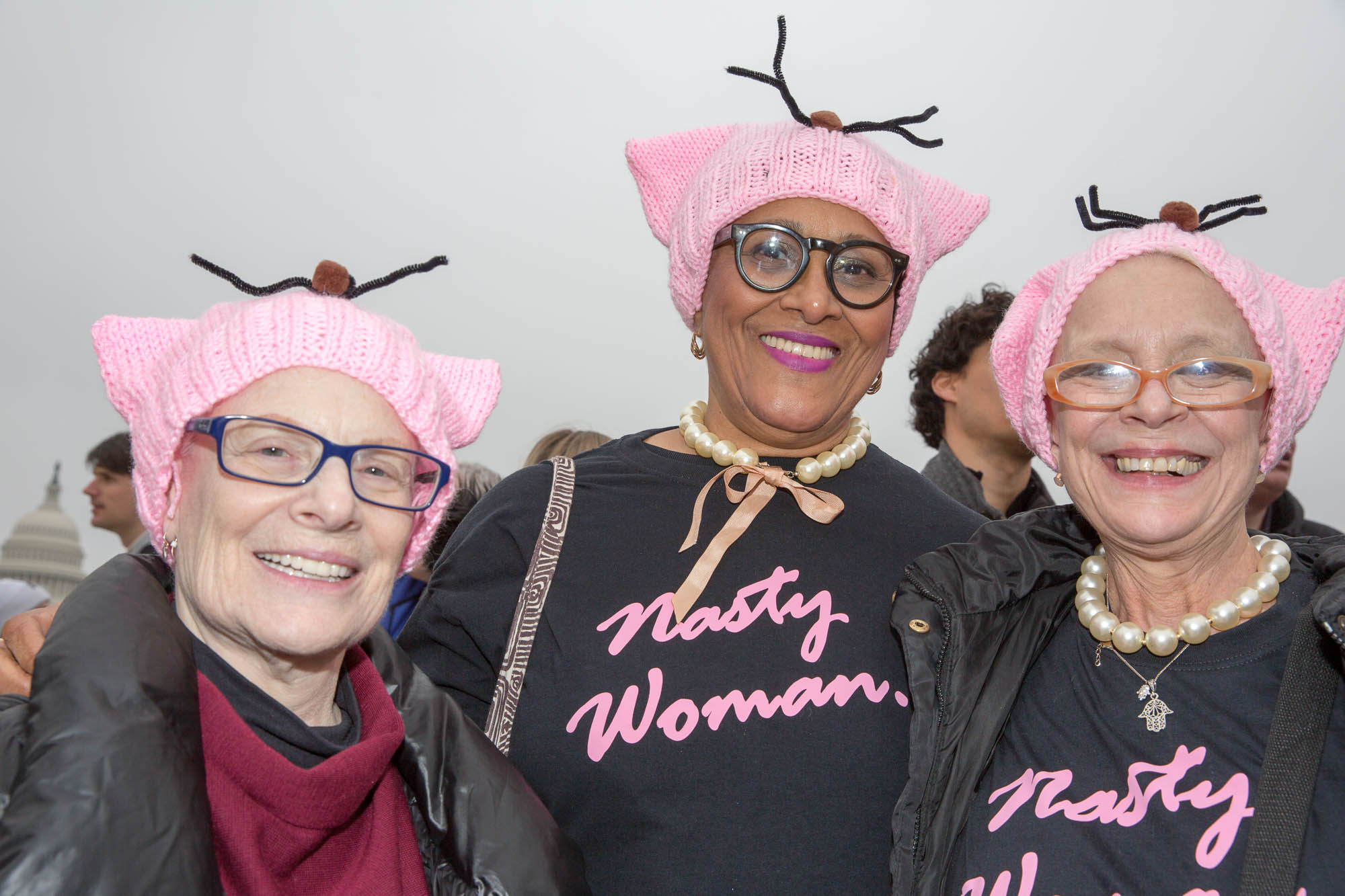
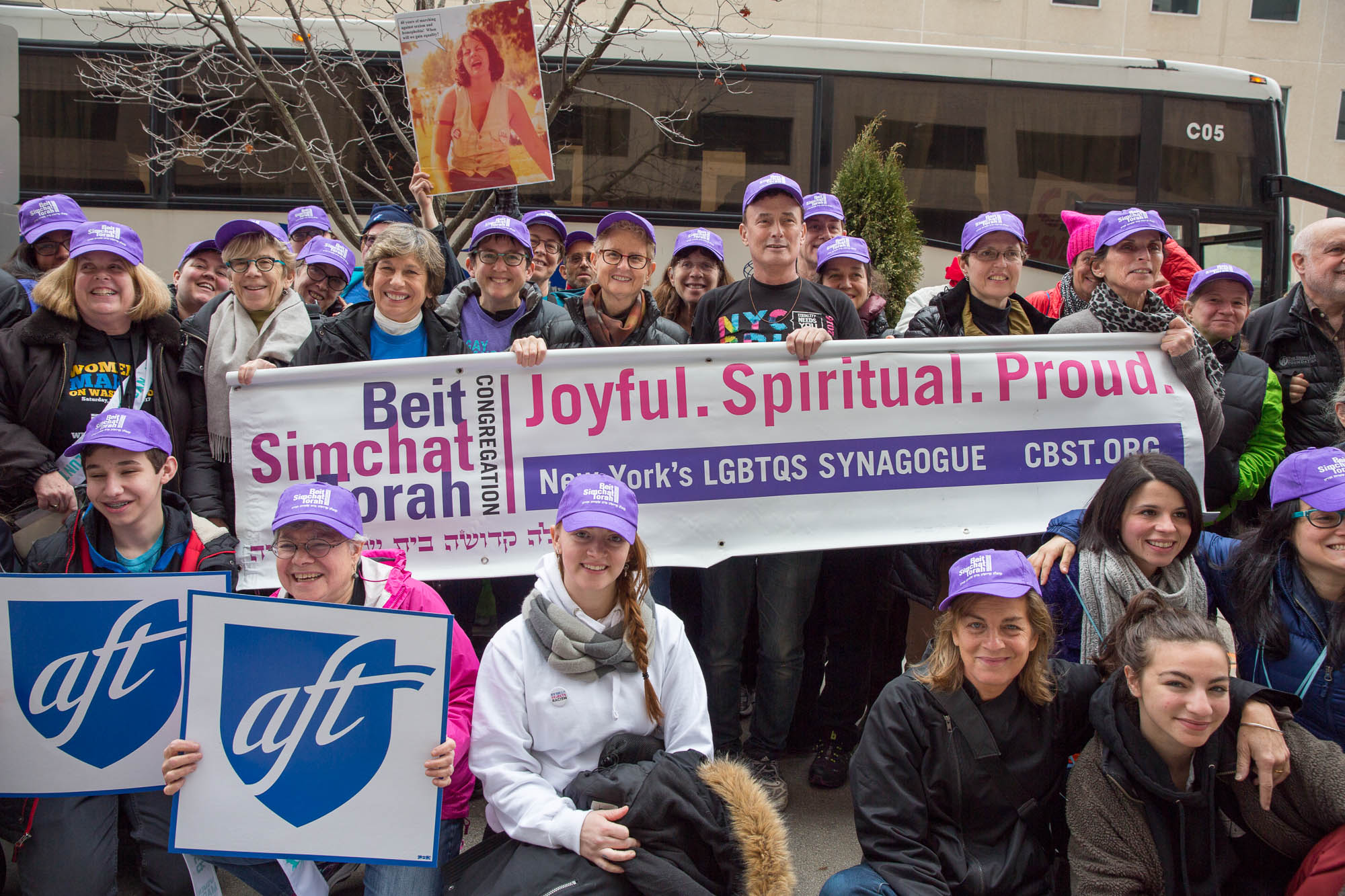
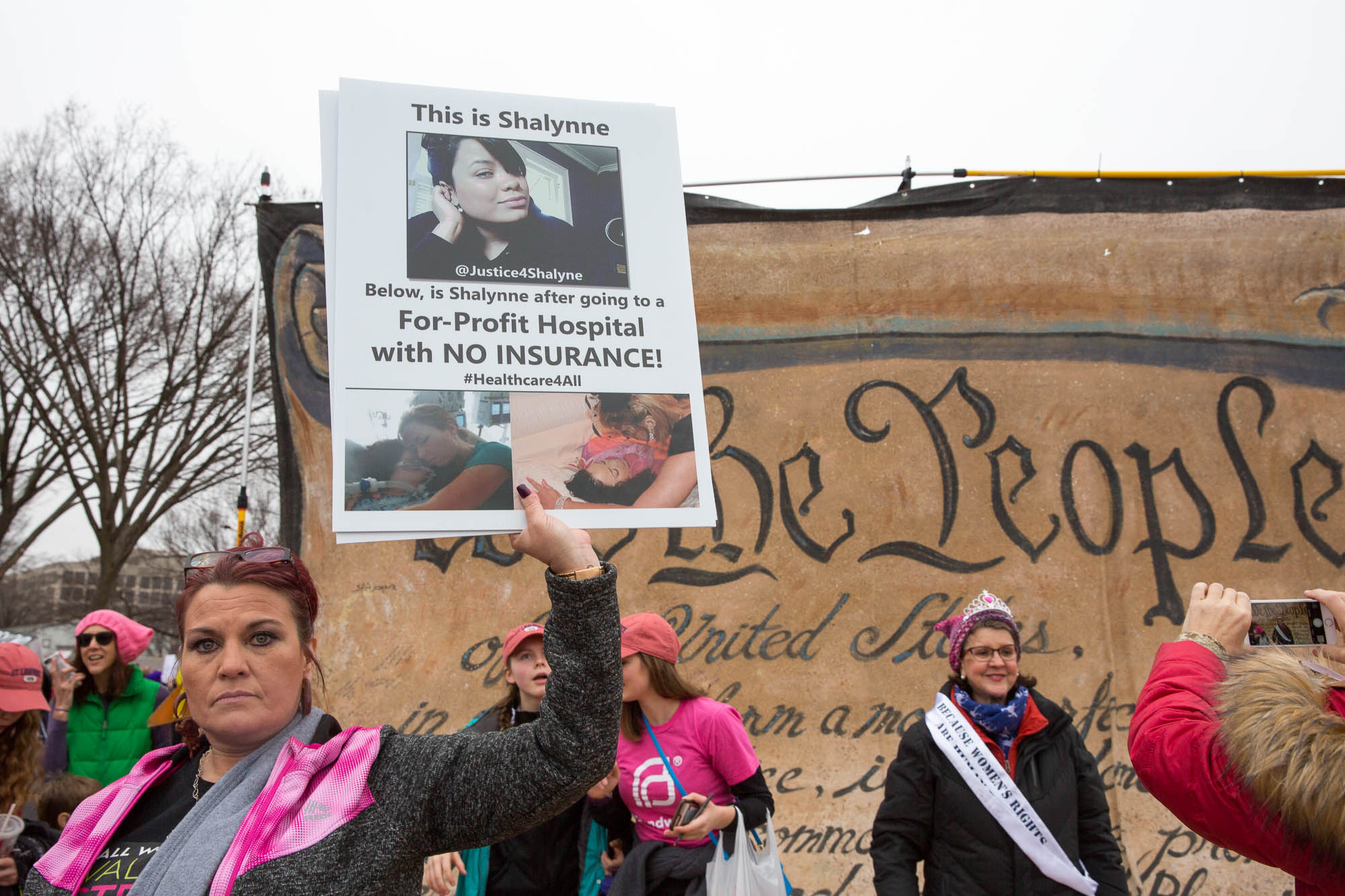
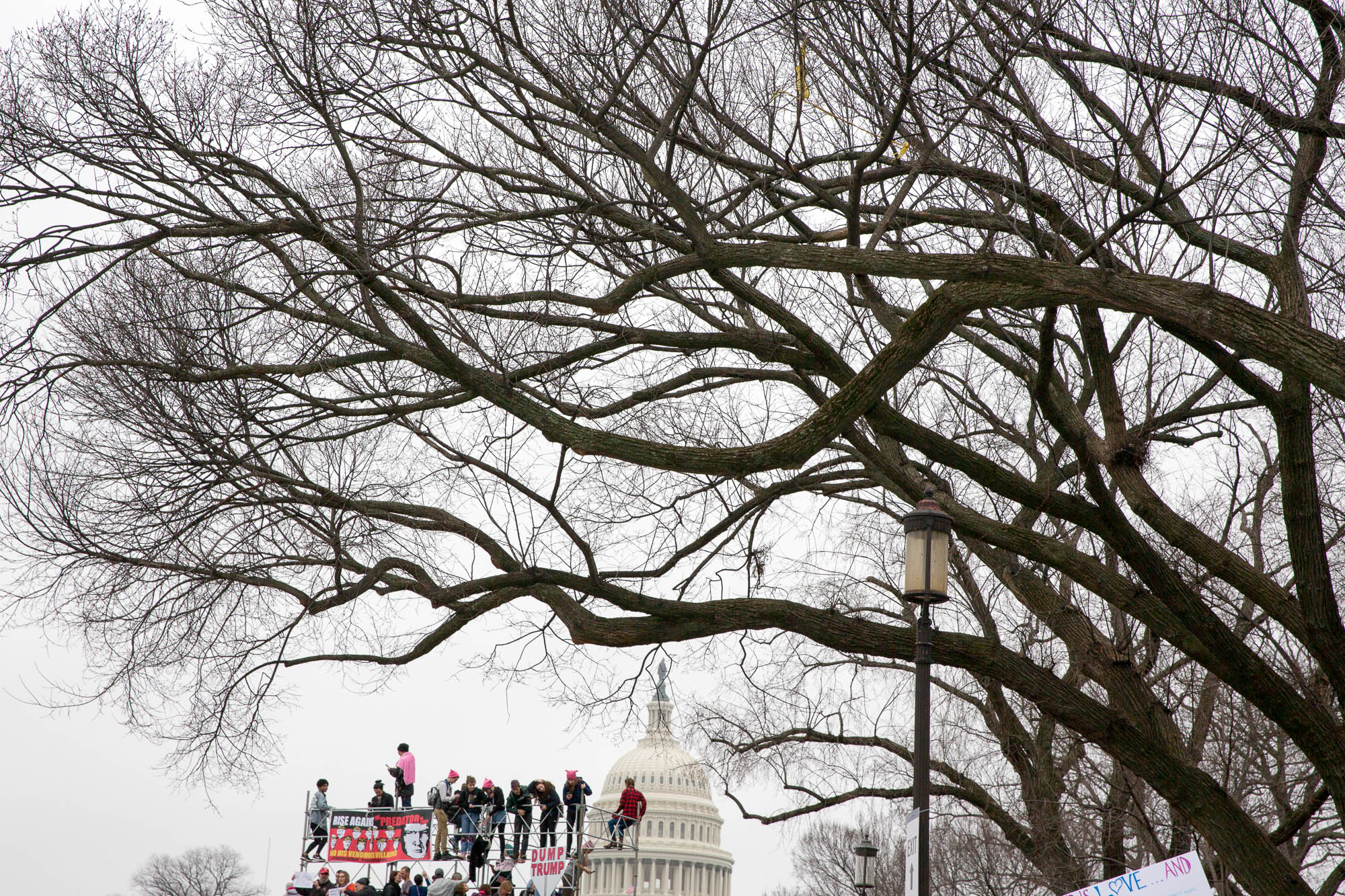
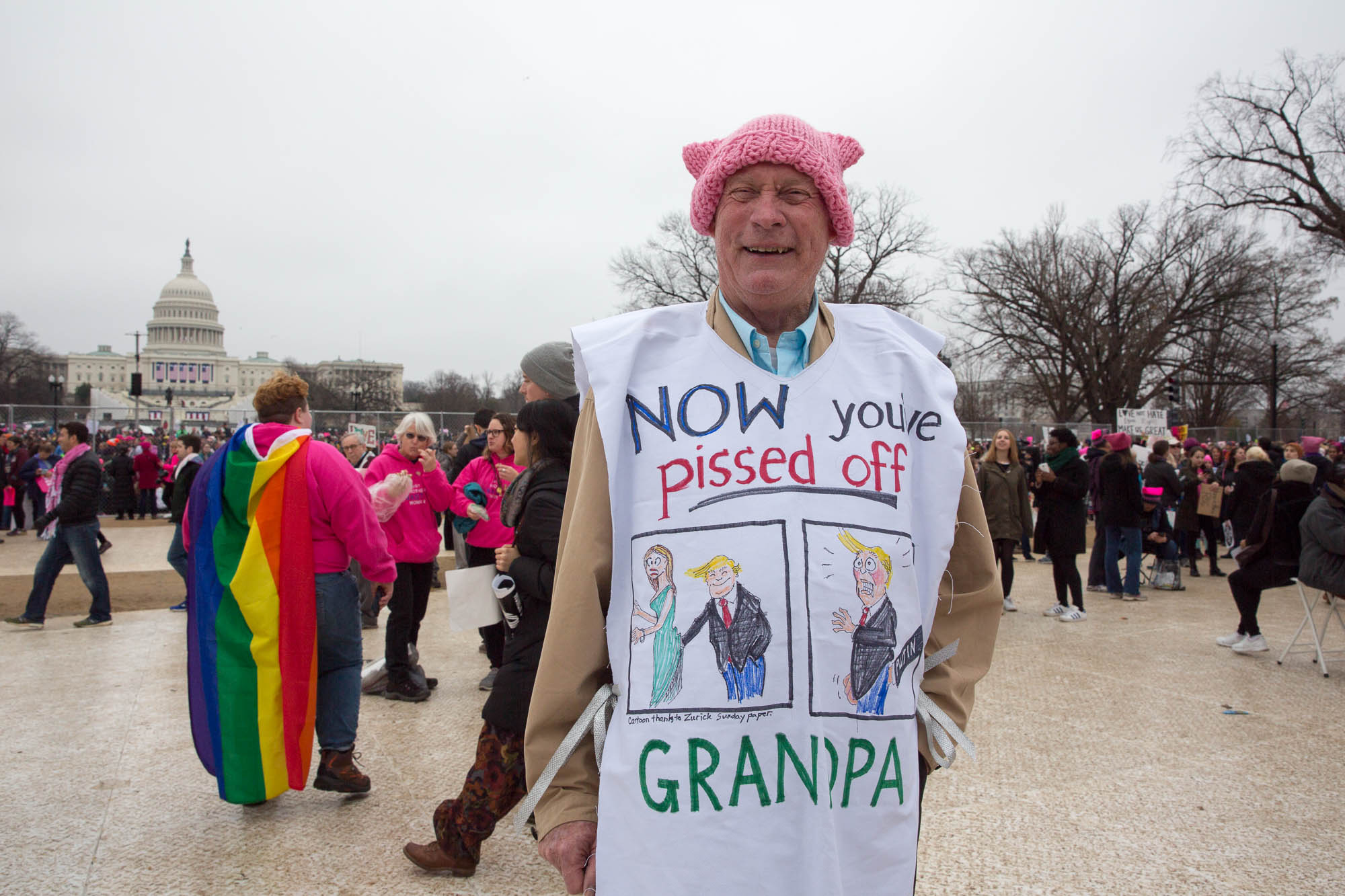
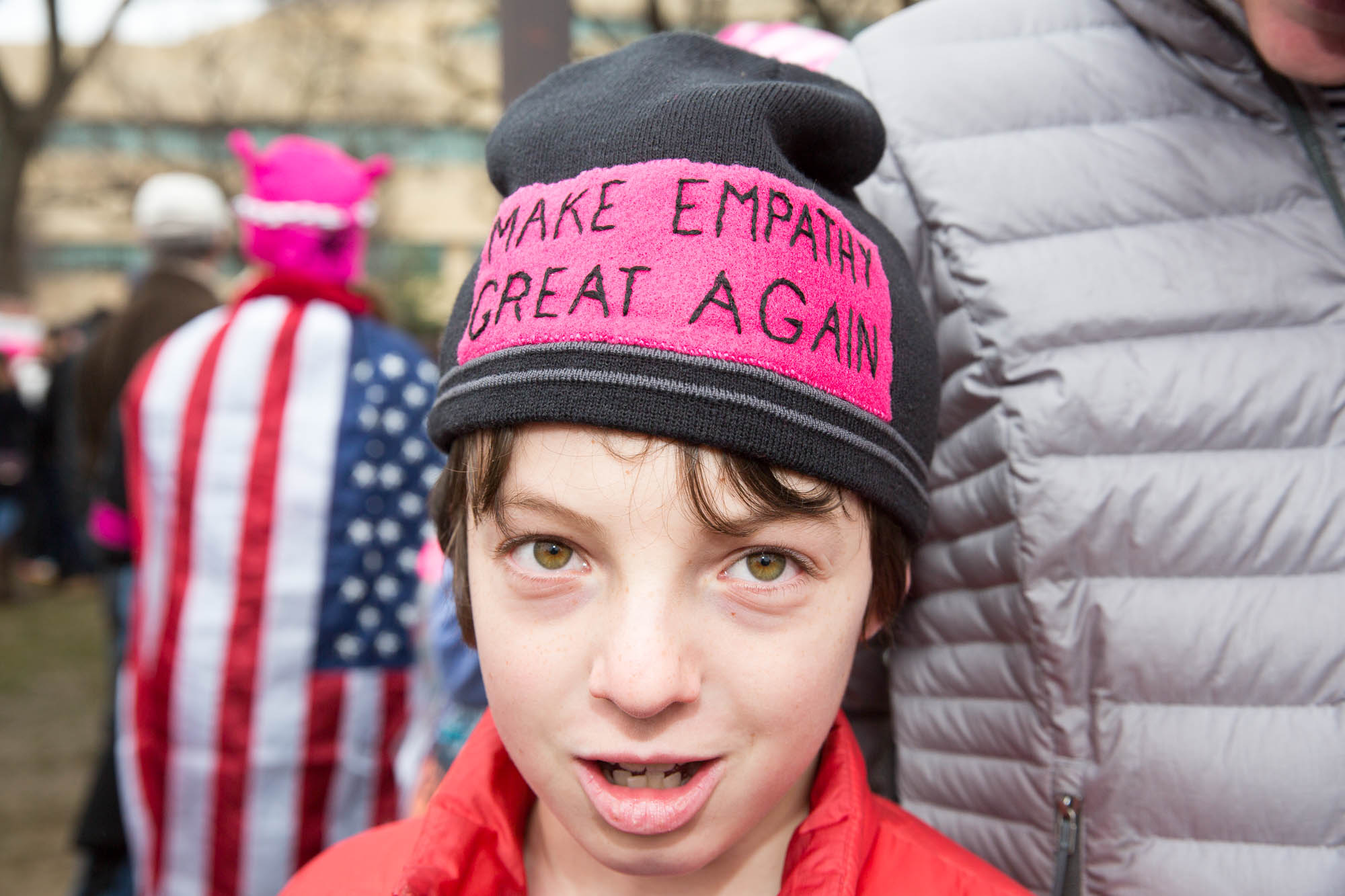


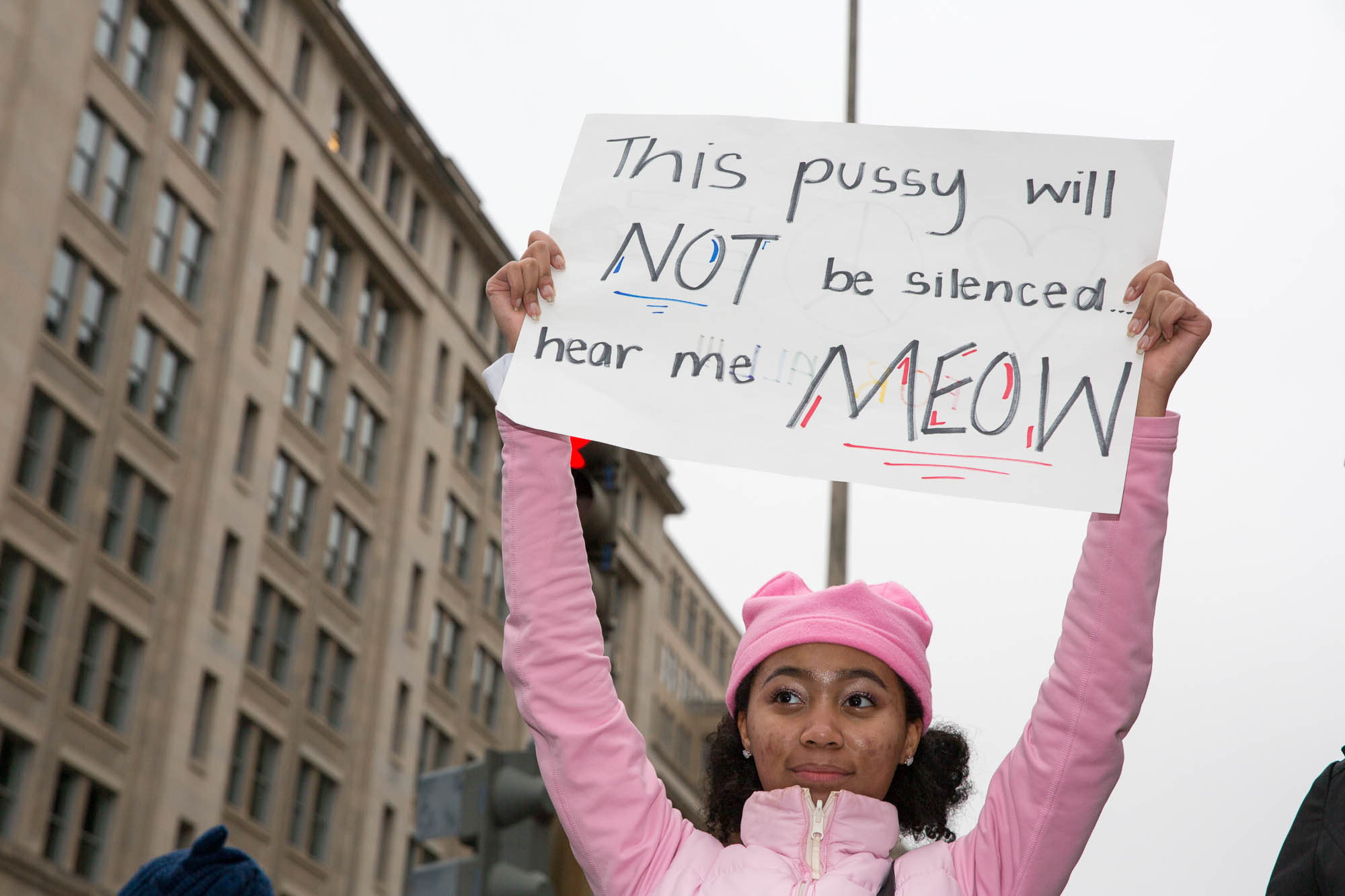
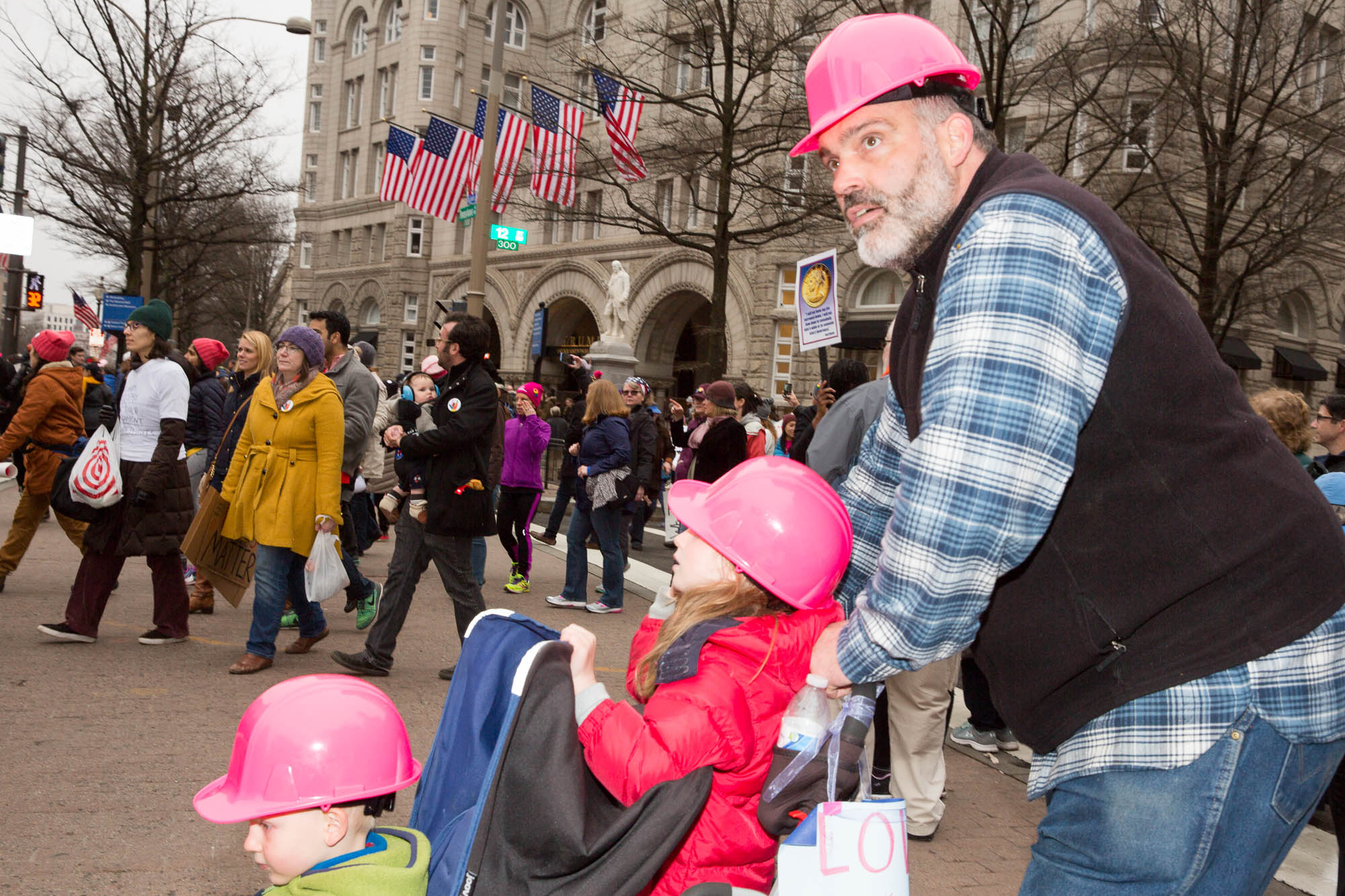
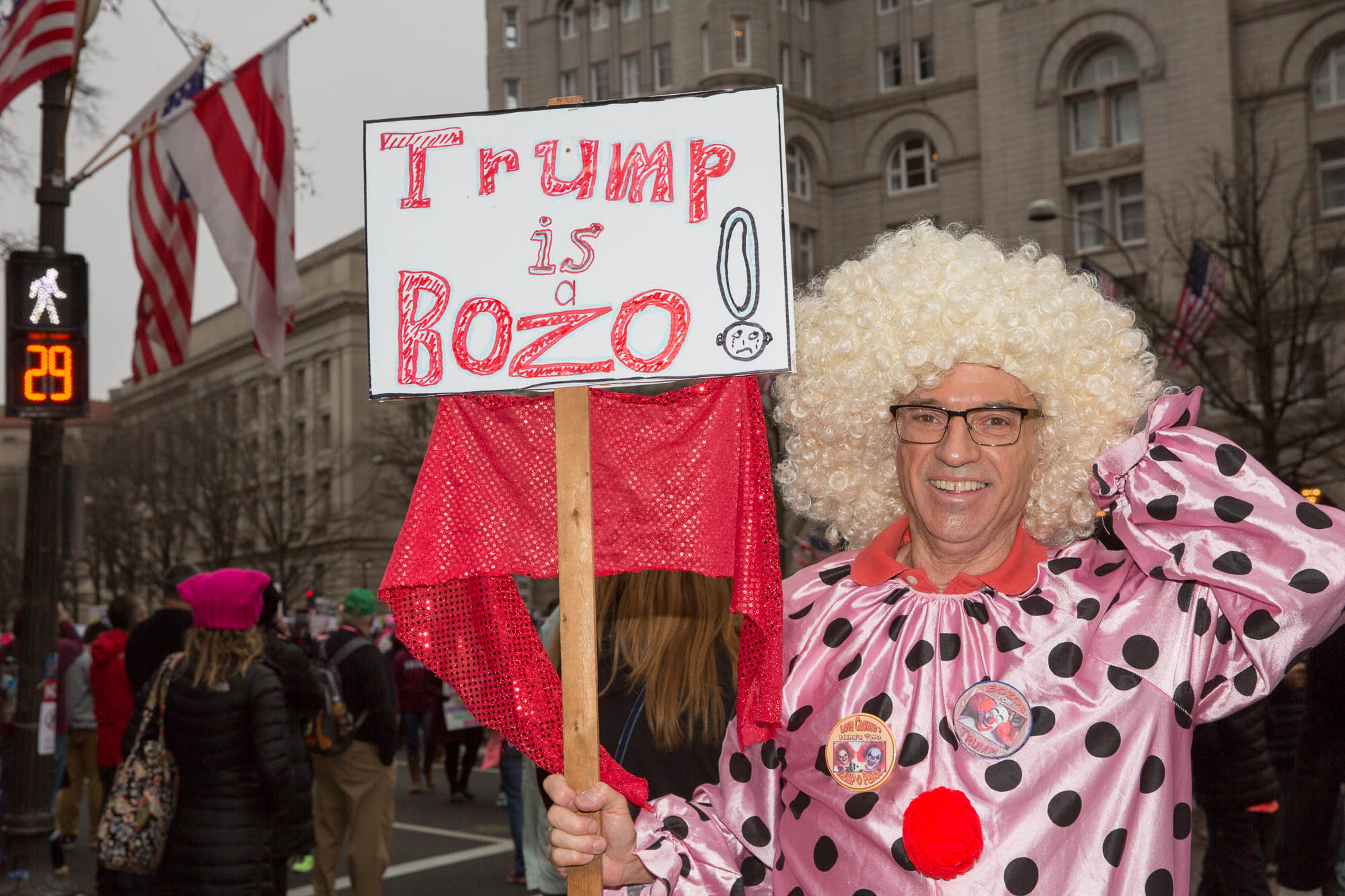
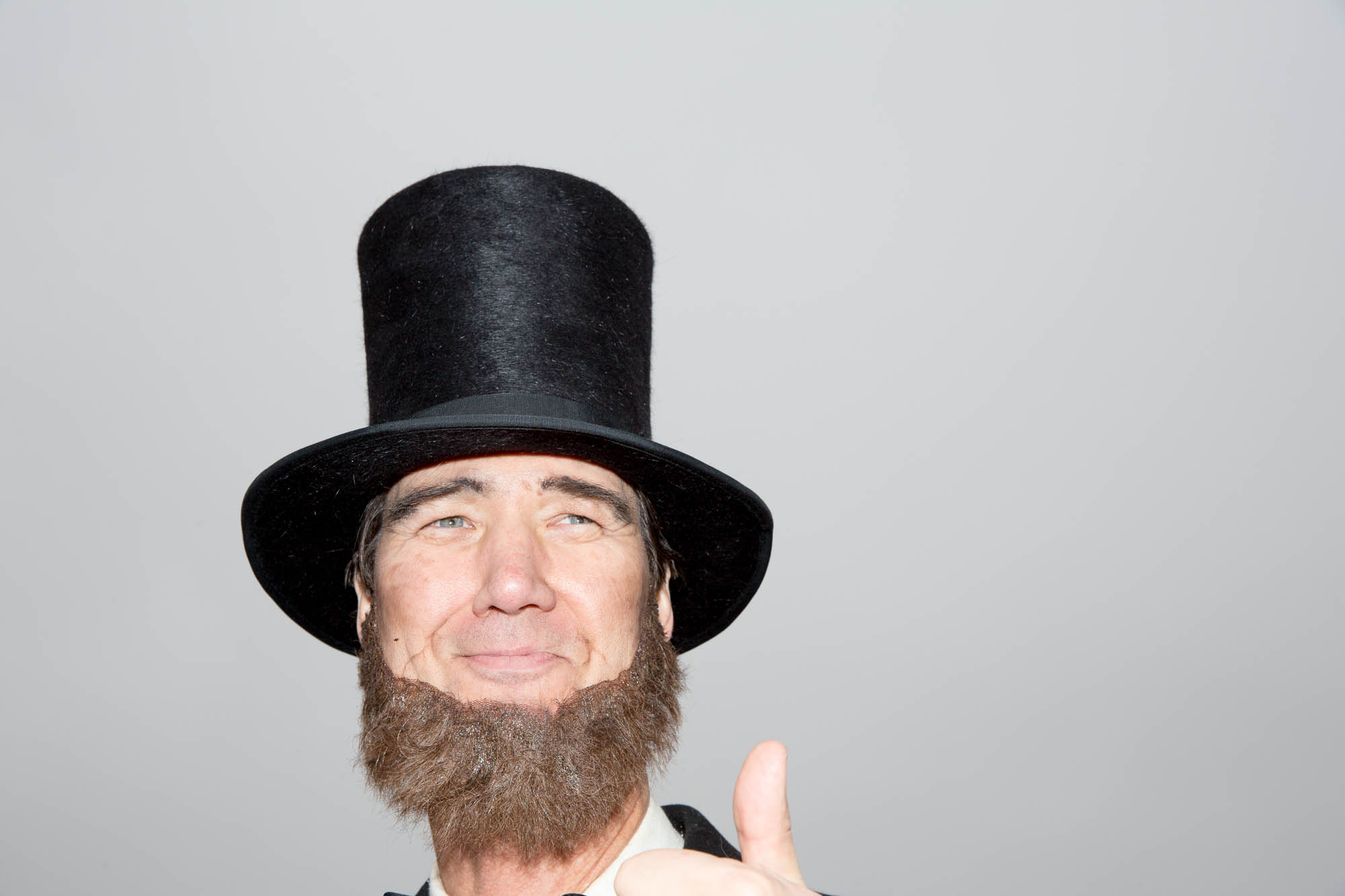
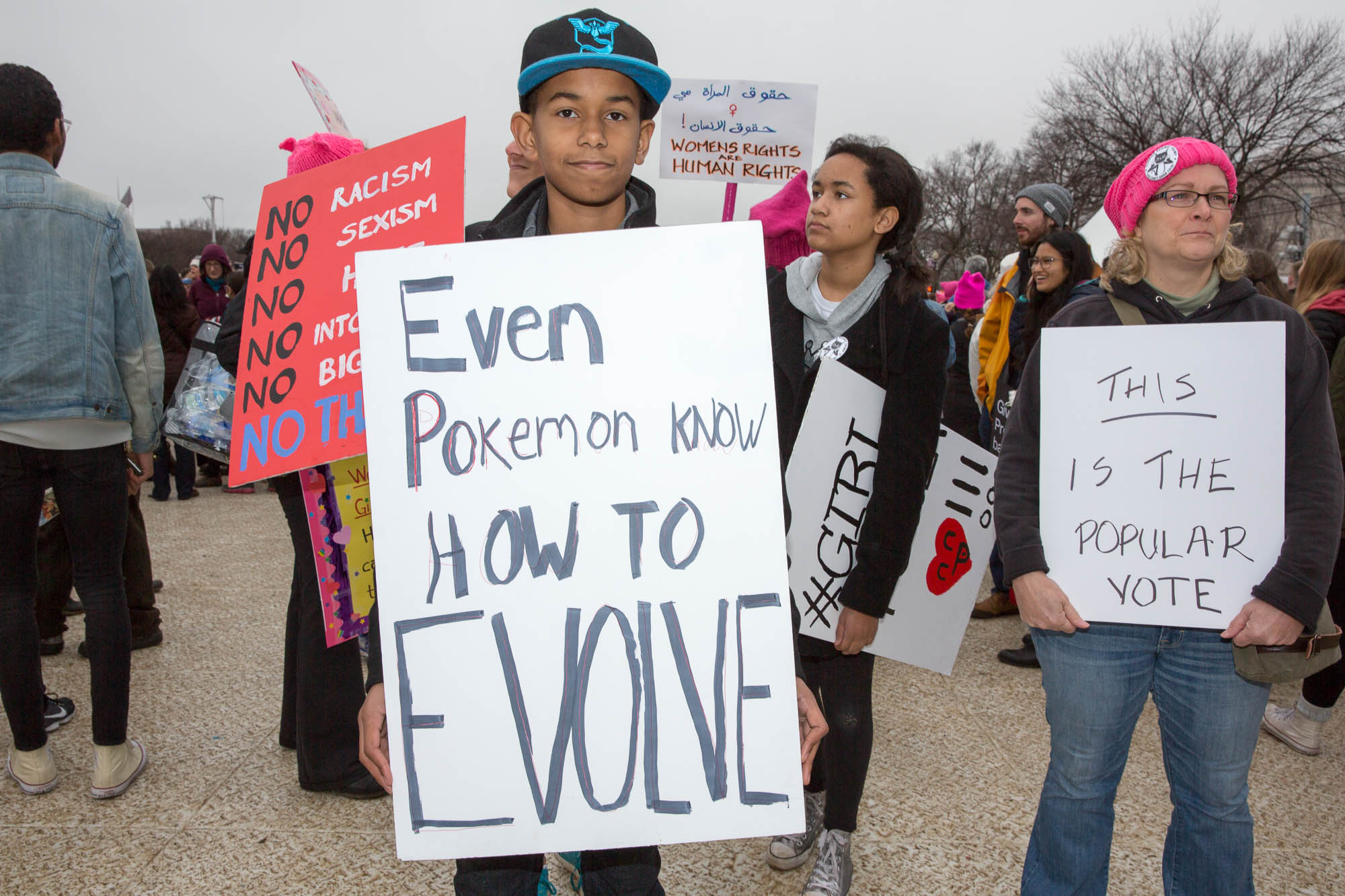

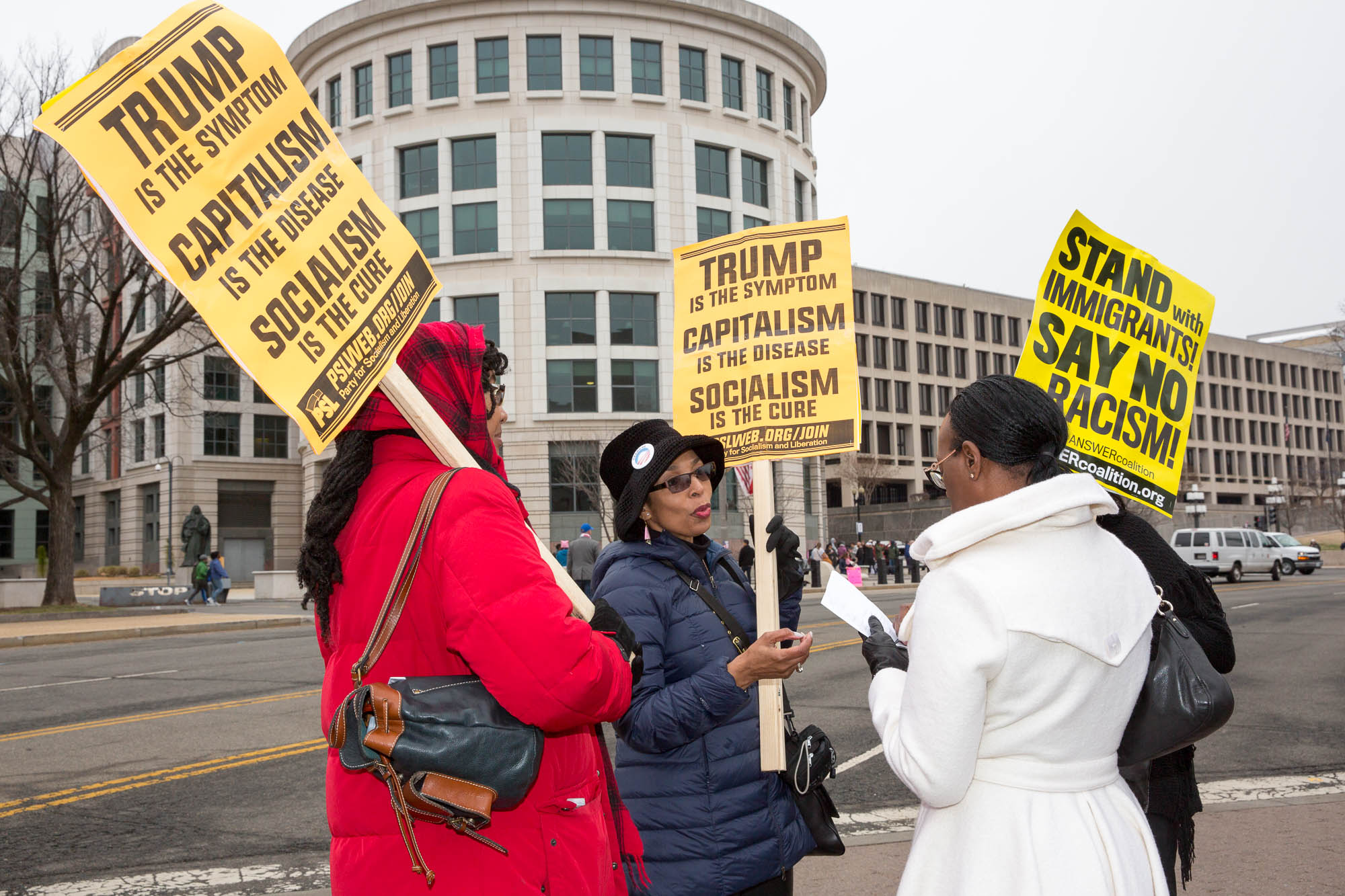

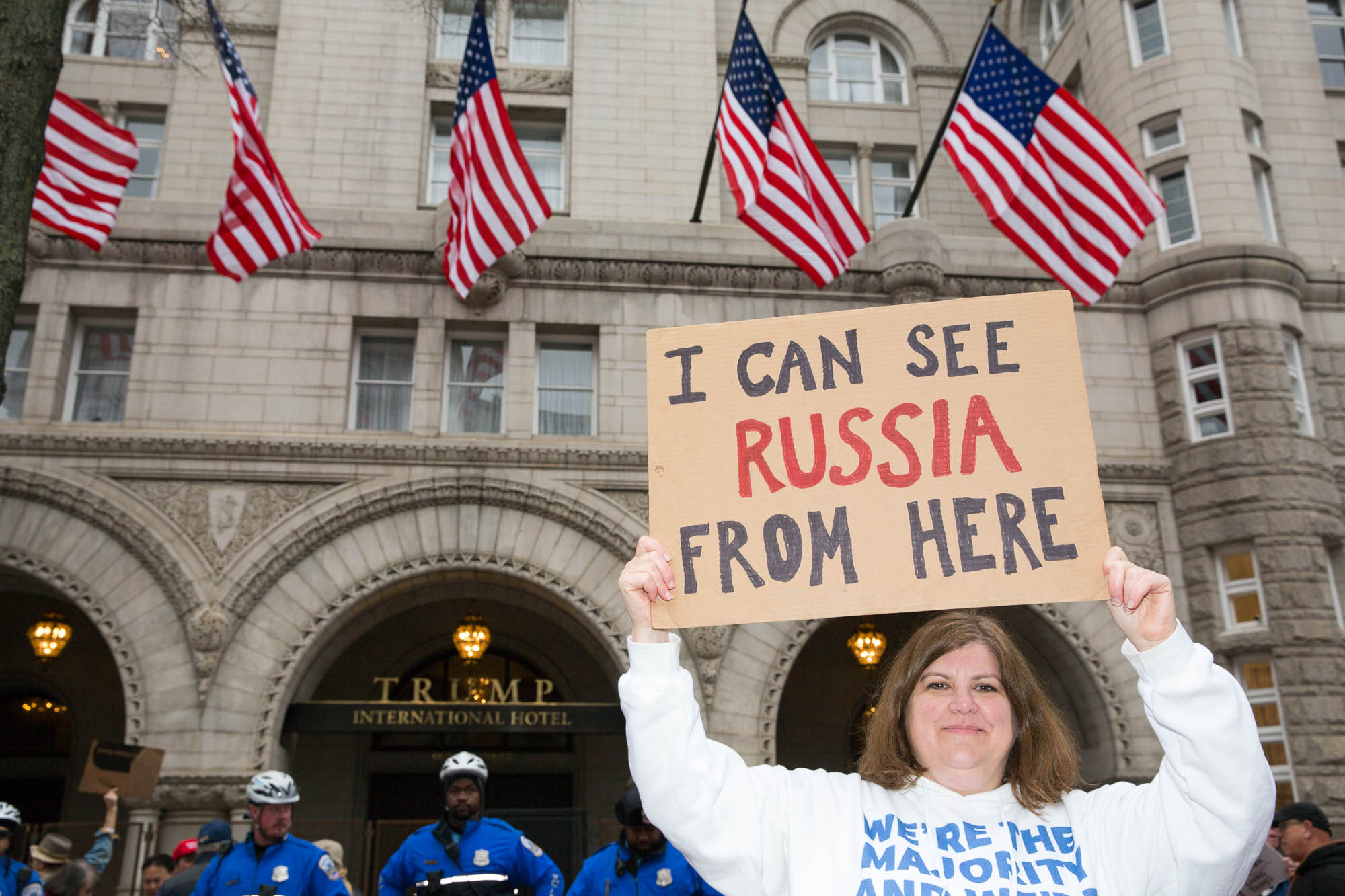

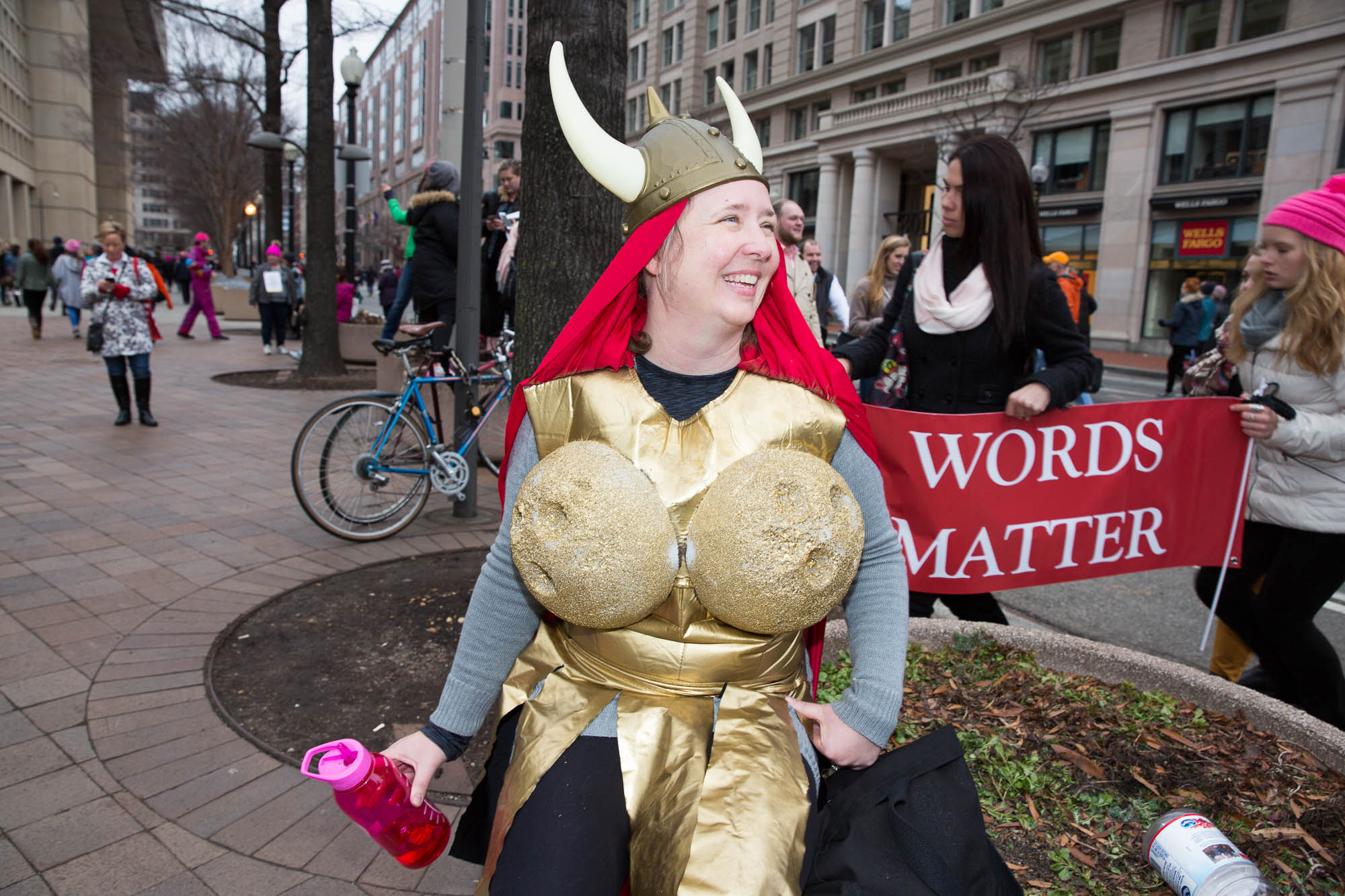
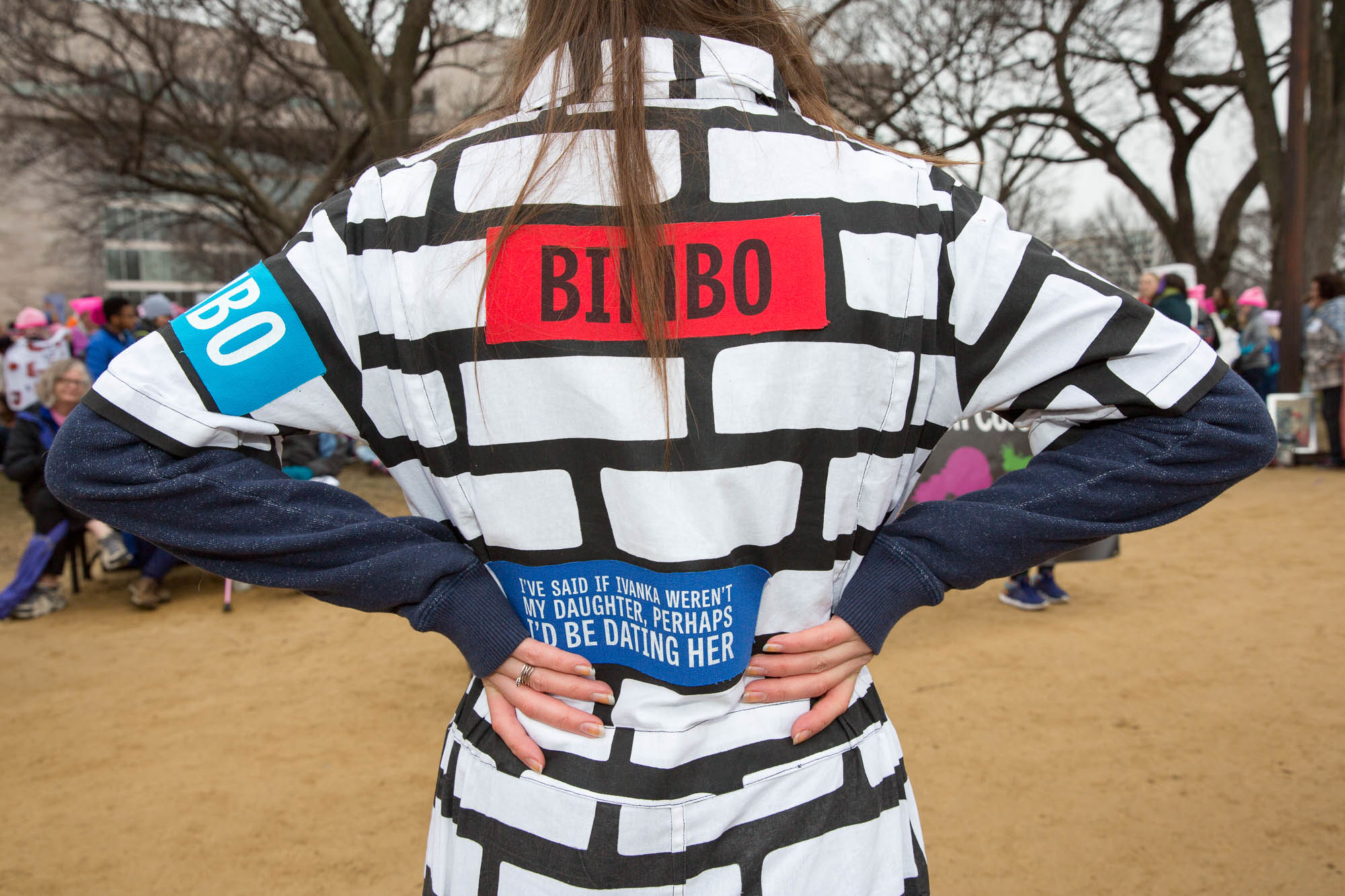
Meryl Meisler lives and works in New York City. You can follow her work here.
Toronto Protesters Tell Us Why They Marched
A few hours before Toronto's Women's March began, I spoke with one of the organizers, Kavita Dogra. She said they were expecting a hopeful 10,000 people to come out. By afternoon, organizers estimated the turnout to be about 60,000. Crowds spanned entire city blocks, closed major intersections, and froze the whole city in time.
Dogra told VICE that the march would set it straight that Canadians are not only standing with the US, but also addressing the issues that women and marginalized communities experience here in Canada.
"It's not like Canada has gender equality; it's not like Canada doesn't have issues of racism and misogyny," Dogra told VICE. "This is an opportunity to send a message to our Canadian politicians that Trump-style politics that have worked in The US will not work here."
Though many tacked the Women's March as anti-Trump, Dogra said this wasn't the main objective. "Anti-Trump makes it sound angry and just about the US and it's not. This is so much bigger than Trump. In the end, our focus is here."
As I marched alongside thousands of diverse, bad-ass, inspiring people, I stopped to speak with some of them about why they were there.
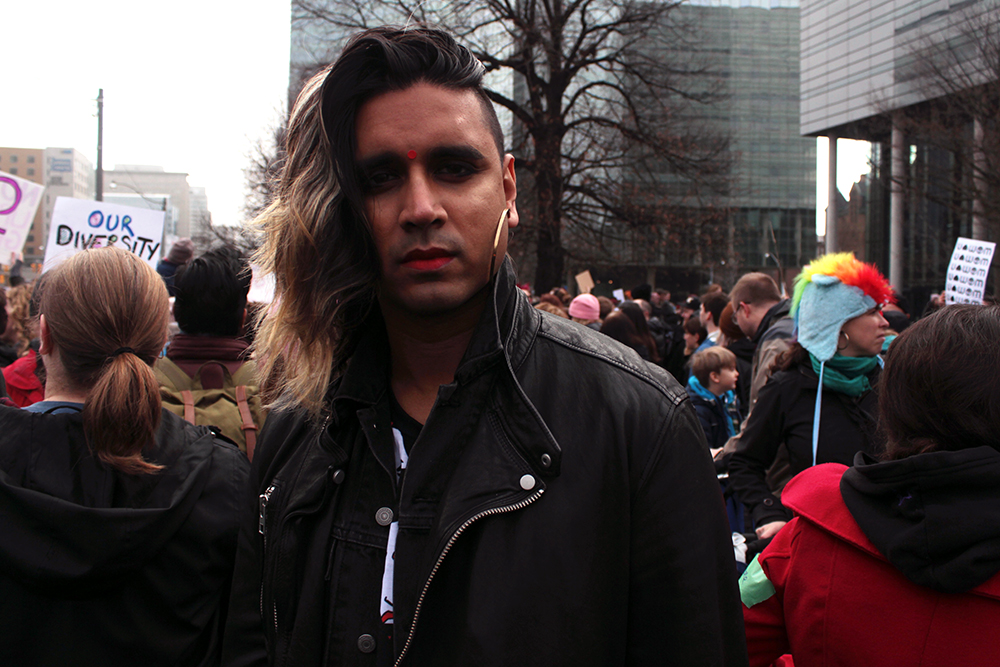
Vivek, 35
VICE: Who are you marching for today?
Vivek: I'm here for women. Also for trans women of colour, it feels very important to me to be present today and support my sisters.
How did you feel when Trump was elected in November?
No words. I felt defeated and I still feel a lot of despair. Being here is trying to conjure a kind of hope and being around other women and other people that care about the kinds of social issues I care about.
Being a trans woman of colour, how have those issues affected you?
Regardless of Trump, I worry about my safety all the time. And now with the election of Trump, I worry about this granting permission for people to be transphobic, for people to be racist. In Canada, we tend to have a superiority complex where we think that we're better and we're definitely not.
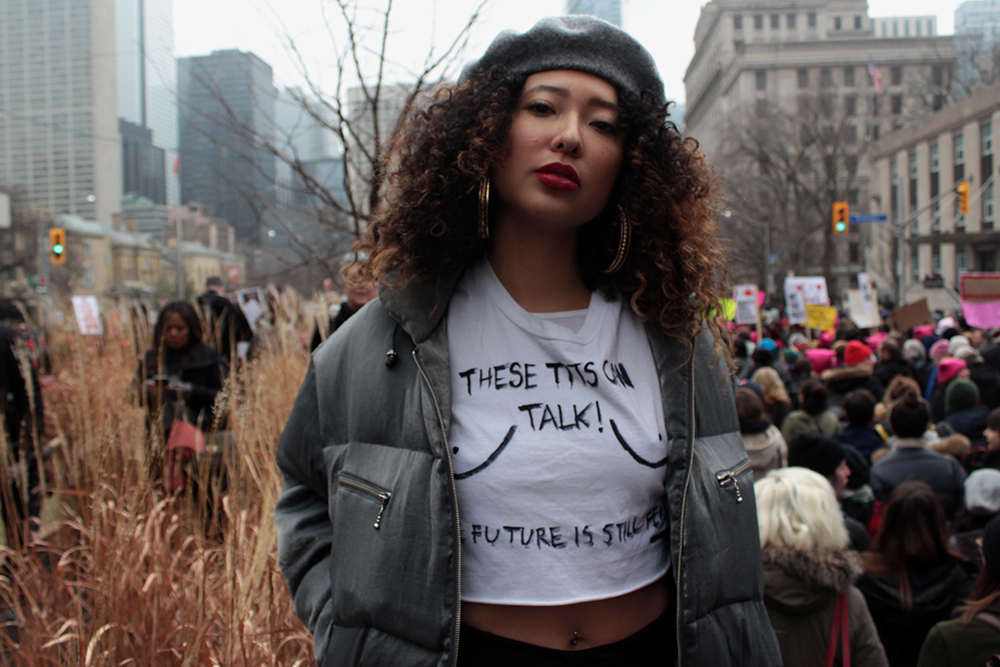
Midori, 24
VICE: What's it like to be here today?
Midori: Just seeing the generations of the people here speaking out and wanting to put forth that their voice can still be heard is so empowering. As a young female, it's extremely moving for me and I'm quite emotional even talking about it now.
You were up here chanting "Black Lives Matter," do you think it's important to represent women of colour?
I come from such an amazing background. But I think what we all need to recognize is that we are all of the same creed and colour, and I don't really like to specify myself as a [woman of colour]. I think that's what we have to move towards.
How have you experienced the effects of racism here in Canada?
I think growing up and being more aware of it as an issue definitely played a role for me. When I stepped outside of this country and saw racism in full and how tangible it could be, and how frightening it could be, that definitely put things into perspective. You know, we are privileged here, but people still turn a blind eye to it.
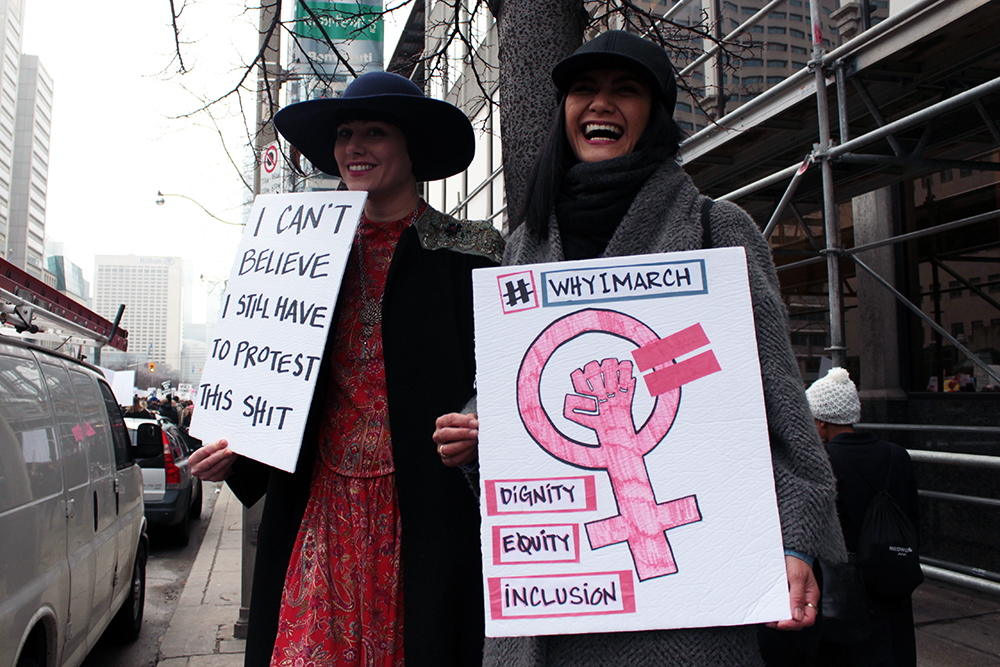
Rina, 40 (right)
VICE: So you say that you're standing up for inclusion, diversity and equality. How have these issues affected you?
Rina: In a huge way. I'm grateful to be working at an amazing company, but I was the only women there for a long time. And therefore the only woman of colour. And you feel your gender, you feel your race first. I was born in Montreal, raised in Canada, but I'm still viewed in so many ways as an immigrant. Yet when a white guy shows up, let's say from the UK, he's an expat. And that division with the way people identify with people of colour is really important. I am definitely here for that.
What do you think will come next?
More signatures, more movements, more leadership. Telling stories that haven't been told before. And facts. I think we're bombarded with a lot of raw media, which is good because it's instant, but to really get to the nitty gritty and find the root of systemic issues.
This is not being dubbed as an anti-Trump rally, but—
If it's the one thing he inspired, because he's not inspirational at all, it's this kind of movement and a revolution we haven't seen in years in Toronto.
How do you think Trump and his office will respond to these marches around the world?
It's not [about] his reaction. I think the people will speak and that's the most important thing.
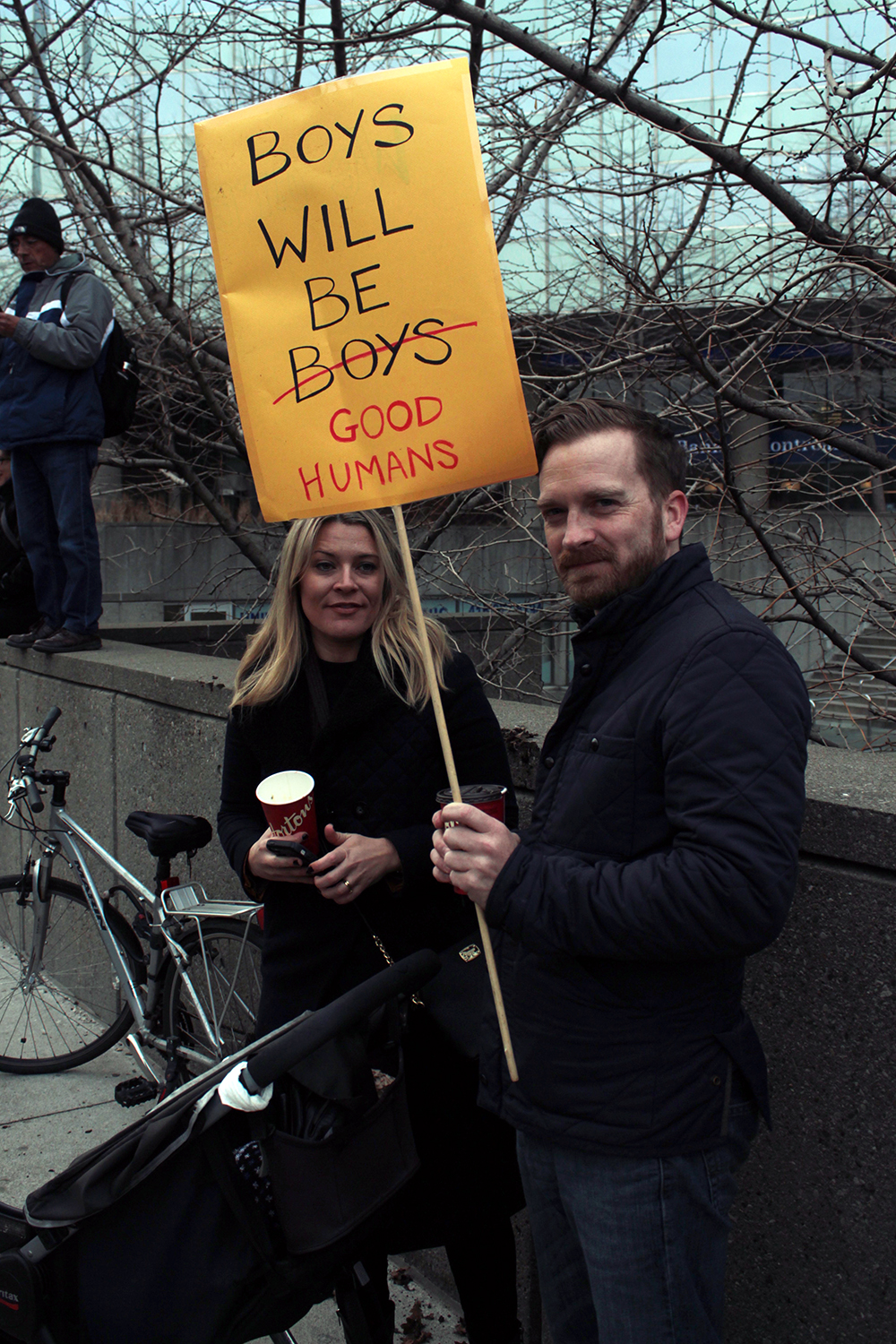
Barry, 39
VICE: Have you protested like this before?
Barry: I have. Not a lot, actually the only major one's I've been to before were the Iraq war protest and when Occupy Toronto started. This seems way bigger.
Have you seen the same social issues here Canada that are currently evident in the US?
Well, Rob Ford, I saw that. We're about to see other things happening with the Conservative leadership race in Canada. I don't believe that Canadians are at all immune to the success of the kind of politics that has happened in the US. It could happen here next week.
On that topic, what are your thoughts on Kevin O'Leary joining the race for Conservative leadership?
I'd like to think that Kevin O'Leary plays a character [on TV] and there's a bit more of a reasonable person there but I think everyone made the same mistake with Trump. So, I don't think we're ensured against anything. I think everyone has to be really vigilant and careful.
So you brought your son out with you today, how do you think this movement will affect him and future generations?
I wish I knew the answer to that. I'd like to think that it's a passing cloud and maybe these things are periodic. The world has seen this kind of movement before and it could happen again.
I think people who are of my age are lucky to be in a generation where we didn't see a lot of giant global conflict but there's a certain way where a lot of people got complacent. Now we're seeing the potential for really catastrophic political movements.
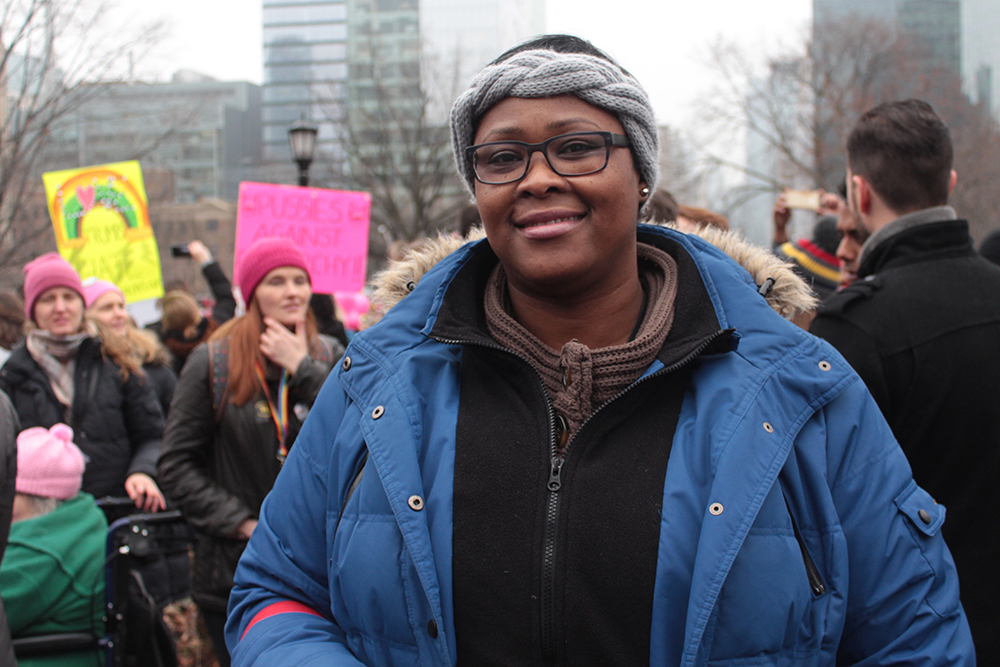
Glacier, 40
Why is it important for you to march today?
For me, it's very serious because I'm a woman of colour, I'm part of the equity seeking group. Whatever changes that are made that are going to be negative against anybody, it's going to impact me twice as hard as it would a white woman or man. I want to make sure that we send a message that people are not going to stand for this. And to see the diversity in the crowd, to see that it's not just women of colour, or just equity seeking groups and that there are a lot of men here, and a lot of white men here lending a hand, it's very heart-warming and encouraging.
You have two daughters; how do you hope this movement will benefit them in the future?
I want to make sure that the world doesn't go backwards and that it goes forward for my girls. We still have a long way to go. Women are still being paid 30 cents less on the dollar compared to men. There's still racism, there's still homophobia, there's still sexism. I want to make sure that I'm part of the fight. I just want a better future for my kids.
Follow Ebony on Twitter.
Revisiting Creepypasta, the Social Horror Craze That Launched Slenderman
Every moment we are online, we teeter on the edge of experiencing chaos. That may sound hyperbolic but consider it for a moment. If you spend some of your day on Reddit, you're already just a few clicks away from seeing videos of real death and despair.
It shouldn't come as a surprise then that online message boards have given birth to an original type of social horror. No, not John Sudano, or terrible social media horror movies, this is something more akin to myths and legends of old, but holds a name that doesn't carry any weight on it's own: creepypasta. It's a collaborative type of storytelling that rearranges found bits of internet text to scare the shit out of everyone who reads it.
Most of us put too much of ourselves online. Nothing helps heal the wounds of modern life quite like oversharing. Creepypasta lives and dies on oversharing. Most creepypasta stories can be found on message boards in strange first-person narratives of a horrific experience.
Take this story on Reddit from a search and rescue officer from the US Forest Service. In a post from late 2015, the officer describes something strange he saw on the job, "on just about every case where we're really far into the wilderness, I'm talking 30 or 40 miles, at some point we'll find a staircase in the middle of the woods. It's almost like if you took the stairs in your house, cut them out, and put them in the forest." It wasn't long before others claimed to see the strange stairs too. Even though this sounds insane, you almost want to go out looking for the stairs yourself just so you can share your story online.
These narratives rely on a collaborative dedication to build a shared delusion. Someone posts their strange horror story and others in the message board can add and elaborate on the narrative so long as they don't break the suspension of disbelief. Everything in a creepypasta is true, even if it's not.
The result is an unsettling fear designed to blur the lines of fiction and reality. Older creepypasta stories like Jeff the Killer or Anasi's Goatman Story went viral because people thought they were real. The narratives don't play by conventional rules of storytelling. Instead, they forego character development and plot to evoke a strange sense of uncanny familiarity.
Take for example, The Russian Sleep Experiment, a story that recounts Russian researchers in the late 1940s trying to keep five people awake for fifteen days. The test subjects were kept in a confined room equipped with microphones and five inch thick glass porthole windows. They were promised freedom if they stayed awake for thirty days. Here's an excerpt of what happened next: "After nine days the first of them started screaming. He ran the length of the chamber repeatedly yelling at the top of his lungs for three hours straight, he continued attempting to scream but was only able to produce occasional squeaks."
Once the researchers opened the room they saw that, "all four 'surviving' test subjects also had large portions of muscle and skin torn away from their bodies. The destruction of flesh and exposed bone on their finger tips indicated that the wounds were inflicted by hand, not with teeth as the researchers initially thought."
The clinical prose suggest that the worst nightmare of all is reality. Even though what you're reading doesn't hold up to scientific scrutiny, the detailed account almost wills your mind into believing it.
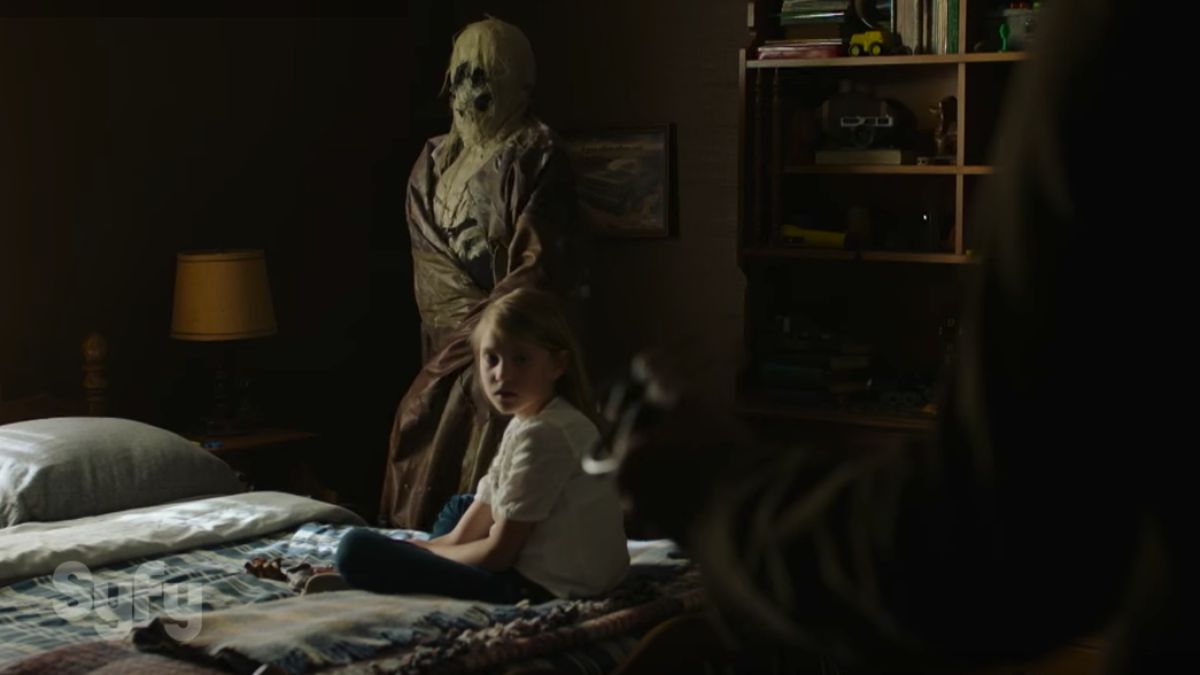
Syfy's 'Channel Zero' adapted creepypasta classic 'Candle Cove' for TV.
The term creepypasta is a portmanteau of creepy and copypasta, a word used on 4chan in 2006 to describe viral copy-and-pasted text. Due to this, there's a weird generational disconnect with creepypasta. The phenomenon went viral on message boards about ten years ago. In the beginning these stories were random bits of junk: anecdotes, language or whatever that had been copied and pasted over and over to construct a story. The majority of them originated on Reddit/NoSleep and can now be found on 4chan, Twitter, Tumblr, Pinterest, Blumhouse, Facebook, YouTube or really any social platform.
These short digestible urban legends still kinda exist under the radar. Hell, there are YouTube videos where people just read the stories that have over three million views. It's a phenomenon. Due to the strange collaborative writing experience, the original authors are sometimes difficult to track down, but that mystery is part of the fun. As soon as someone posts the story, someone can repost and add to the story. Academics call it digital folklore: modern mythmaking at the behest of social media.
Jeff Tolbert, a folklore professor from Indiana University Bloomington, suggests creepypasta represents a process he calls "reverse ostension." Ostension is the process of acting out a folk narrative. Creepypasta does the opposite by creating a set of folklore-like narratives where none existed before through a collective effort. According to Tolbert, this involves the creation of new objects and new disconnected examples of experience, and involves the combination of these elements into a body of "traditional" narratives, modeled on existing folklore.
It seems Tolbert could be onto something as right now the most popular creepypasta's draw on real world familiarity with topics like YouTuber antics gone wrong, a sentient evil computer program locked away on the deep web and poisoned cans of Redbull.
By drawing on the familiar, writers can expose real fear and receive immediate feedback on their story. The audience can easily help steer the narrative. No Sleep writer, TheJesseClark summarized the appeal to VICE, "It's a great little niche on the internet where you can hone your skills and get quick feedback and fanbases that you can market more ambitious projects to for free."
Although Jesse writes stories that represent what's currently popular on Reddit/Nosleep he did say that "It's easy to see why it was popular and successful in the past. Everything's free, and success is simply due to the quality of your ideas and execution. It's one of the purest ways to share content."
Older creepypastas relied on the purity of the forum experience to go viral and pop culture is taking note. Now stories like Candle Cove, and Slenderman are stepping off message boards.
Candle Cove was recently adapted by SyFy into an an incredible television series. The story follows a group of adults who all remember watching an old pirate kids show when they were children but it turns out they were only watching static. The television show stayed true to its roots by creating a moody and surreal narrative that elaborated on the tale in true creepypasta fashion. The end of the original story is the end of the first episode in the series, everything that happens next is new.
Then you have Slenderman. Perhaps the most famous of all the creepypasta stories and the only one to escape the internet and take root in the real world. The Slenderman is a thin, unnaturally tall man with a blank and featureless face, wearing a finely tailored black suit. He is found in a variety of stories but is most commonly stalking children. He's been featured in many different video games and literature. His existence was even the source of a moral panic in 2014 after two girls tried to sacrifice a classmate to the Slenderman. The event, known as The Slenderman stabbing is the subject of a new documentary from HBO films— Beware the Slenderman, launching January 23.
Obviously the two young girls at the centre of the documentary were not able to separate the fiction of Slenderman from the reality. The dedication to suspension of disbelief that is key to creepypasta proves Grant Morrison right when he says, "things don't have to be real to be true. Or vice versa."
The modern mythmaking involved in creepypasta allows each separate story to persist outside of a message board environment. As the experience is shared and reshared it grows and begins to exist on its own right. No one point of view has a full grasp on the story and by removing a fixed protagonist the story ensures that together we only have own thing to remember: the monsters.
By making horror a social experience, readers can no longer hold the aspects of a story at a distance. Creepypasta stories signify a profound recollection and familiarity within the reader. The reader is drawing on moments from their own life. You can either add to it or walk away.
Of course, that's just for people who partake in it. For those of us on the outside these stories can seem absurd and at times laughable. Most people will find it impossible to believe that any of these fictions are real. They may even demand that readers carry a better authority over their imaginations and step away from the experience.
According to Stephen King horror, "... deliberately appeals to all that is worst in us." Those that love horror know the truth of that statement and sharing the experience of horror only elevates its effectiveness. Just ask anyone who's seen The Exorcist in a sold out theatre. By making these short horror stories digital folklore, creepypasta creates a community of people ready to share in the confrontation with something they're afraid to see alone, but afraid not to see together. After all, what good is suffering if not shared?
Follow Zac Thompson on Twitter.
Spending Time Around Traffic Is Literally Destroying Your Brain
The highways around where I live in Portland, Oregon are like congestion voids—black holes or boundless oceans. You go in hoping to reappear elsewhere in the city or beyond, but without any assurance of exiting at all; time and space cease to have any meaning as waves and waves of Subarus roll toward the horizon. As once-plentiful provisions of Planet Money podcasts dwindle, you can feel madness setting in.
As it turns out, being around traffic for extended periods of time may have a very real effect on the human brain. This is according to Health Canada-funded research published this month in the Lancet that looked at the neurological health of two large-scale populations living in Ontario consisting of several million adults each. The study found that those individuals living closest to busy highways suffered from significantly increased rates of dementia, a symptom of irreversible neurodegeneration.
Specifically, the study found that up to one in 10 cases of dementia could be attributed to traffic exposure. This backs up earlier research finding that living near roadways—and the associated air pollution—can be tied to "insidious effects on structural brain aging."
See the rest of this article on MOTHERBOARD.
Get Ready for a New Chapter in the Long Legal War Over Abortion
Among the many things Donald Trump has promised to change in America is abortion. He's vowed to overturn Roe v. Wade—the landmark Supreme Court decision that gave women the right to choose to end pregnancies—"automatically" upon taking office, and he has essentially guaranteed social conservatives that his pick to replace the late Antonin Scalia will support their agenda. Though he was once personally pro-choice, Trump changed his mind in the past couple decades, and as president seems fine with supporting the policies backed by Republicans like Vice President Mike Pence.
But overturning Roe, which marks its 44th anniversary on Sunday, will not be simple. More likely, Trump's Supreme court will move in a pro-life direction gradually, allowing states to pass restrictive laws that make it harder for women to get abortions. In other words, we can look forward to more years of legal battles.
To figure out what that battle will look like, I called up Carol Sanger, a professor at Columbia Law School and an expert in reproductive rights. Here's what we talked about.
VICE: Let's start with the basics. What did Roe do, exactly?
Carol Sanger: The Supreme Court found that the right to privacy [protects women who want to have abortions]. The word privacy isn't mentioned in the Constitution, but there are a number of provisions in the Constitution that add up to a zone of privacy, like the police have to have a warrant to search your house. So under the idea of privacy, the court said, making an intimate decision about such a major thing in the shape of your life is covered by the right to make other important decisions about private aspects of your life. That's how they got there.
Since Roe v. Wade, other words have been used to describe the nature of that right. The Supreme Court has described it as a "liberty right," also covered by the Constitution, or a "right of autonomy." These terms all go to the notion that being able to decide important things about the shape of your own life is a protected interest and the state can't just come in and take it away unless they have a really, really good reason.
What other cases have built off of Roe?
There's a second case that modified what Roe said. And that's Planned Parenthood v Casey, 20 years later. Casey was a challenge to Pennsylvania statutes that regulated abortion every which way. Women had to notify their husbands before they could get abortions, women had to look at pictures of fetuses, there was a waiting period—there were many, many regulations around consenting to abortion. And there was a heavy appeal to the court by pro-life advocates who said, "This is your chance to correct what you did with Roe." And the court said, "No, we're not going to do that. We're going to uphold the basic holding of Roe."
But the court also said that the court didn't get everything right in Roe. One of the things that they didn't get right was the state's interest in "potential life," as the court called it, although now they're calling it "unborn life." Roe had said that a state's interest in embryonic or fetal life starts after the first trimester—that meant until 12 weeks, the state could only regulate [abortion] in basic ways: clean facilities, licensed doctors, stuff like that. Casey said, no, a state's interest in potential life starts at the moment of conception. This meant the state could start regulating abortion in the first trimester, and that opened the door to all sorts of regulations.
There's one other case, which came up last summer: Whole Woman's Health v Hellerstedt. Casey had said an abortion statute is unconstitutional if it creates an "undue burden" on the right to have an abortion. The equivalent phrase they used is if a statute places a "substantial obstacle" in a woman's way, that's an undue burden. They figured out that in the Texas case, [because of the law that was being challenged] so many clinics would close that a significant percentage of women would have to drive 150 miles [to reach a clinic]. More would have to drive over 100. Some would have to drive over 200, and so on. And they said, it can't be good for women's health to have them crammed into the few facilities that are left—we're going to strike it down.
"You don't really have to overturn Roe to make a dent in the ability of women to get an abortion in a sensible, fair way."
So how could a more pro-life Supreme Court roll back some of these rulings?
The first thing that will happen is not an overturning of Roe v Wade but just a backing off of Whole Woman's Health. You could say, "Oh we don't think it's a burden for them to have to drive so much." That's what the lower court had said in a related case. Then you're just back under the days of Casey, when states could do pretty much whatever they wanted. So you don't really have to overturn Roe to make a dent in the ability of women to get an abortion in a sensible, fair way.
Many states pass statutes against abortion saying things like, "We're passing this statute to improve women's mental health. We don't want women to feel guilty." What the court said in Whole Woman's Health was, "We're interested in medical benefits. You have to actually prove it." Pro-choice advocates think that's great, because it means states can't say anything they want [about in court] and carry the day.
If the [new court] decides that Whole Woman's Health only applies to the kind of things that were regulated in Texas, and limit the holding there, maybe states don't have to make such a big showing. States may be able to just say, "We say these are the facts. We think women will feel guilty," rather than having to point to studies that prove that. That would be the best way to cut back quickly on the right to abortion.
Conservatives will get another justice on the Supreme Court because there's already a vacancy that Trump will fill. But will one extra pro-life justice be enough to overturn Roe?
It's certainly not enough to do that. That's probably three or four justices away. But it might be enough to limit Whole Woman's Health.
"It's going to be important that judges don't just roll over and become political animals."
How likely is it that new justices will work as hard as they can to roll back abortion rights?
In Casey, some of the justices said, "If we'd been on the court when Roe was decided, we never would have voted for it—but we're on the court now, and we think people have gotten used to the right of using abortion if contraception fails." They said there wasn't a strong enough reason to get rid of Roe. New justices appointed by Trump might decide that they're not supposed to overturn something just because they disagree with it politically.
It's going to be important that judges don't just roll over and become political animals. We have a Republican House and a Republican Senate and a Republican presidency, but we should have a neutral court.
Are there any cases moving through the system now that could challenge Whole Woman's Health?
There's nothing on the cusp. One of the ways cases get heard by the Supreme Court is that there are issues where some appellate courts go one way and other appellate courts go another way. And there aren't that many [abortion] cases now that are contradictory to each other. It's going to take a couple years, I think. before anything gets to the Supreme Court on abortion.
In the unlikely instance that Roe v Wade were overturned, would pro-life activists just declare victory? Or would they find further battles?
Sincere, religious pro-life advocates believe abortion is murder and some of them oppose the death penalty on the same account—they're consistent in their belief that life should not be taken. But I think that hating Roe does work way beyond that. There were two things available [to conservatives] to show what a horrible, immoral society we've become: One was gay people and the other was women who choose abortions. I can't think anything else having the same power as a moral issue. I wonder if they really, really want it overturned.
So you think this issue is shorthand for a lot of other things, in a way?
I think it's shorthand for nostalgia, for the way America ought to be, in some views. I think it's a way of saying women should be at home with children, not working. It stands for a whole outlook on how life should be. And abortion just turns it topsy-turvy.
When women have a truly unwanted pregnancy, they will end it. We know what women did before Roe. They had abortions. They went to Mexico, or they self-aborted. People treat it as though it's something women do on a whim, why can't they just buck up and have another baby? It's quite something to become a parent against your will.
What can pro-choice states do to strengthen abortion laws?
What they can do is they don't enact nonsensical regulations. And that's a good thing! I think there's going to be a lot more differentiation between states [when it comes to restrictions on abortions] and so there'll be a lot more traveling. If it's really hard to get one in your state, you go to another state, and that's kind of how it was before Roe. Everyone traveled to the states that respected a woman's right to choose.
This interview has been edited and condensed for clarity.
Follow Allie Conti on Twitter.
The Canadian Women Who Marched on Washington
Every day after the election of Donald Trump, I walked into my Toronto workplace with my shoulders hunched as if expecting another blow. The lone American, I had assured Canadian coworkers that there was no way Trump would be elected president. In the weeks after, I felt like a dog that had been kicked.
But no more than a week after that stunning event, I walked into the office and was stopped short by my coworker Carolyn. "There's going to be a protest in DC, and my friend and I are thinking of going," she said. She wanted to know where they should stay, and I—a Washington native—promised to consult on safe, transit-accessible neighbourhoods after I grabbed a double-double.
I stood in the line at Tim Hortons and thought about which neighbourhoods I should direct them to. I thought about what it meant that these Canadians were willing to shell out airfare and leave their homes and kids to get involved in the politics of my fucked-up country. And I felt, for the first time since the election, a little bit of warmth replace that hollow feeling that I'd been carrying since the night I watched the results come in on a seedy bar on Bloor Street.
And that's how I ended up taking the afternoon off work, flying out of Toronto, and hosting six Canadian women in my parents' house in the DC suburbs.
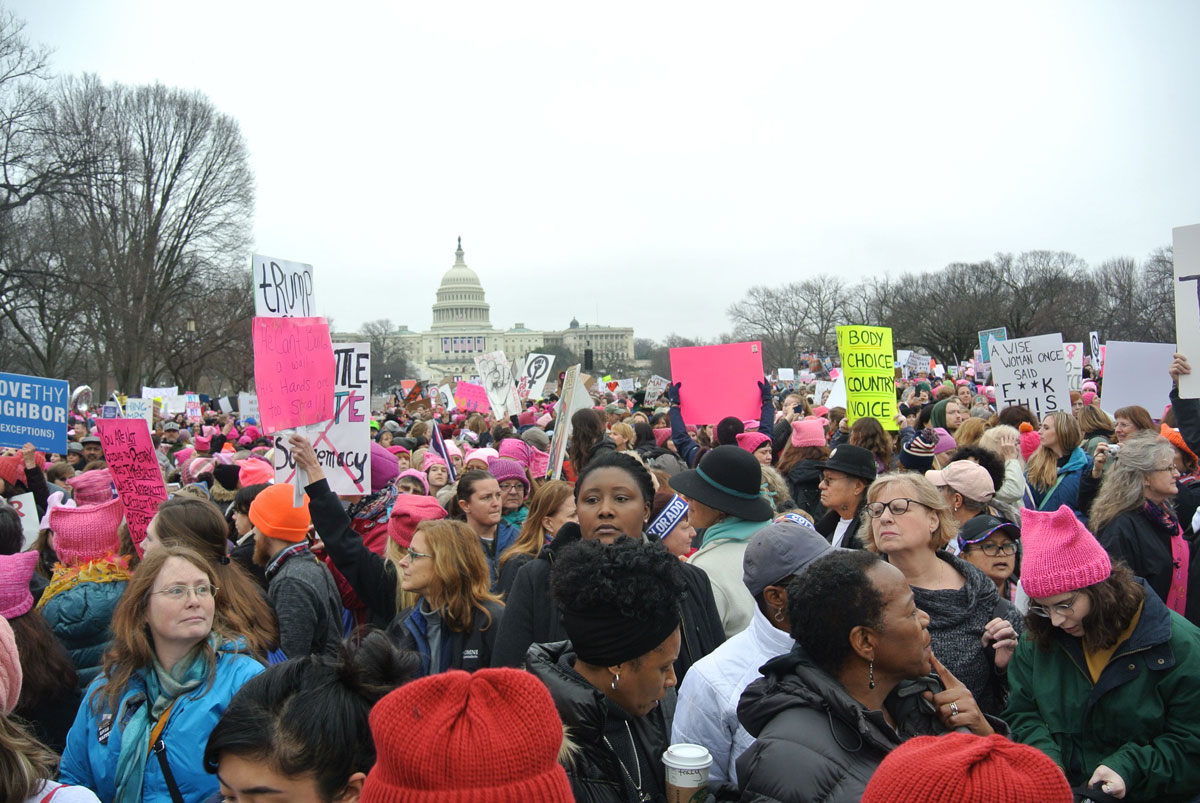
All photos via the author.
On a break at work, I asked Jenn and Carolyn—both teachers, like me—why they felt so driven to attend the event.
"I was so angry and sad when that video came out," Jenn said, referring to the infamous recording of Donald Trump talking to Billy Bush. "I felt it physically. And I was so sad that that was the reality of who this man was, and people still supported him."
For Carolyn, it was about the close relationship between Canada and the US. "American politics are part of our everyday culture," she said. "Trump's victory resonated because Canadians have a vested interest in what happens in the states. When you meet an American woman and you're talking to her, we're so alike.
"I feel like it could be us."
Read More: Toronto Protesters Tell Us Why They Marched
Our plane out of Toronto was packed full of women attending the march, all wearing pink knitted pussyhats. I smiled at them as I found my seat, wondering why they felt compelled to come to my hometown.
So the next day, in the crowded streets around the US Capitol, I asked them. And this is what they told me.
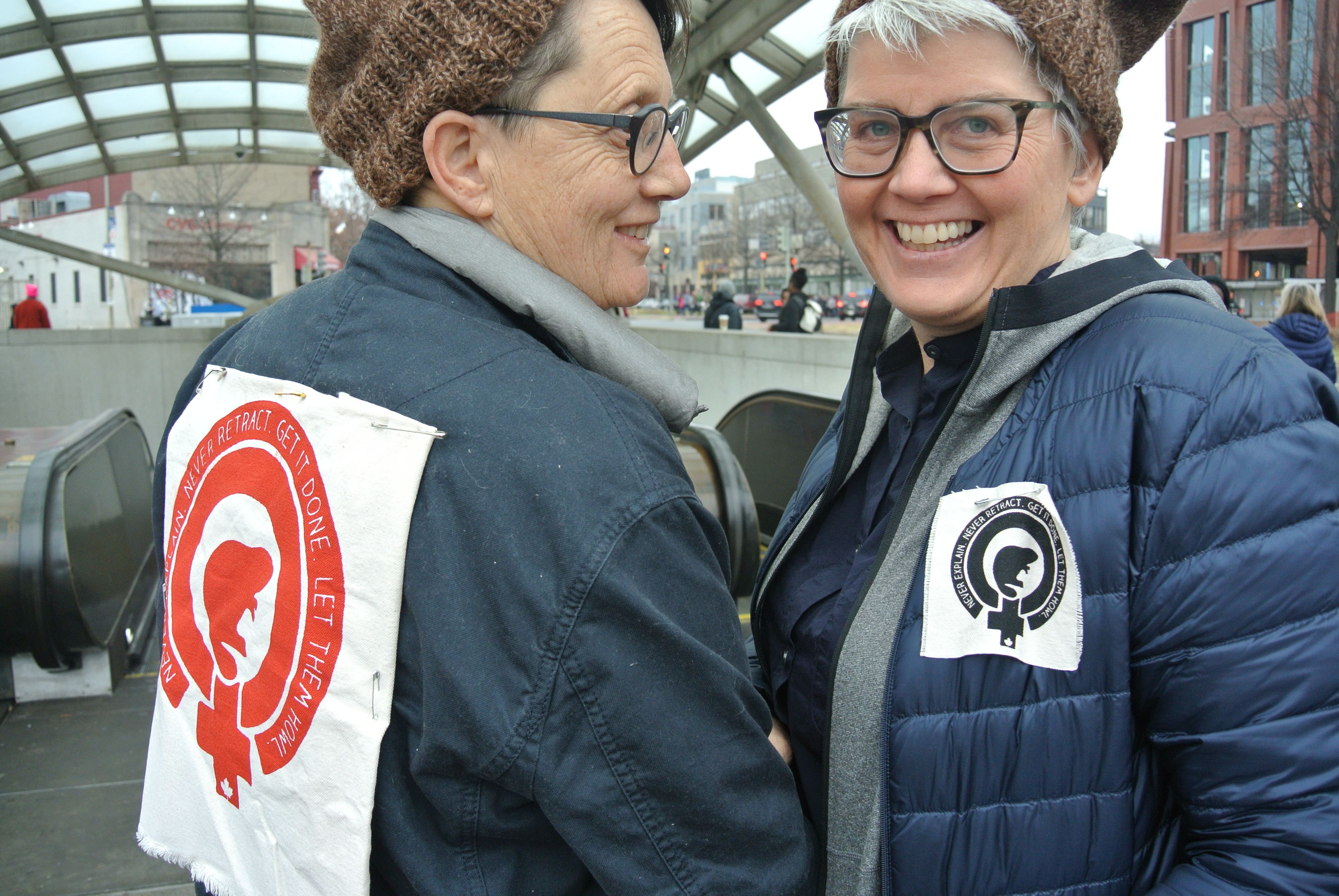
Jane Farrow (right) with partner Annabel Vaughan
Jane Farrow, 55
Occupation: "I am free" (actually, she's an author, broadcaster, and community organizer)
Jane: "I'm here to stand in solidarity with the brothers and sisters of America who are having a shit time with a nasty bit of business in the big chair.
"It's really important for people to feel like they're not alone. It's incredible to have been here yesterday during inauguration—the streets seemed completely empty, like it was a ghost town, and now you're standing with hundreds, thousands of people. They're converging, they're walking right by—all the hats, the signs, people are smiling...You know, you get a lump in your throat. You're here to just kind of go, "Hey, we are not going to stand idly by and let this happen."
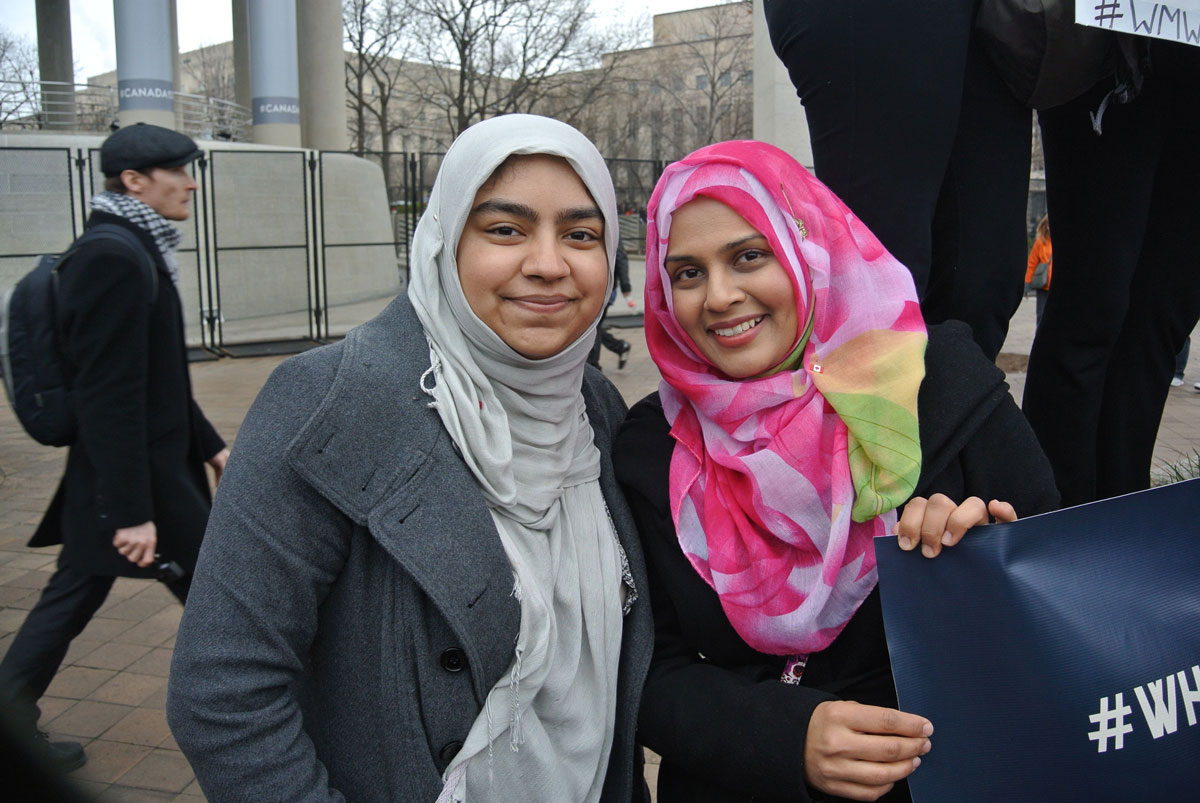
Sadaf Jamal (right) with friend Ujyara Farooq, 22
Sadaf Jamal, 38
Occupation: runs a health and wellness program for Muslim women
Sadaf: "I'm here because ...as a Muslim woman, I believe we have to come together, stand for equality, and then if we see any injustice happening anywhere we stand up against it. And then we support people who are marginalized. There's nothing wrong with being different; there's everything wrong with marginalizing those people with differences. So we are here to empower everybody and give this message on behalf of Canada: to stay strong, stand strong, and you belong here."
Ujyara: "I don't think this is just for Trump, this is a stand against injustice. Canada—as much as I love it, it's not exempt from it. So we're here just to show that hey, we're going through the same thing, let us stand with you, you stand with us. So I don't think this is necessarily just about American politics. It's about the state of the world right now."
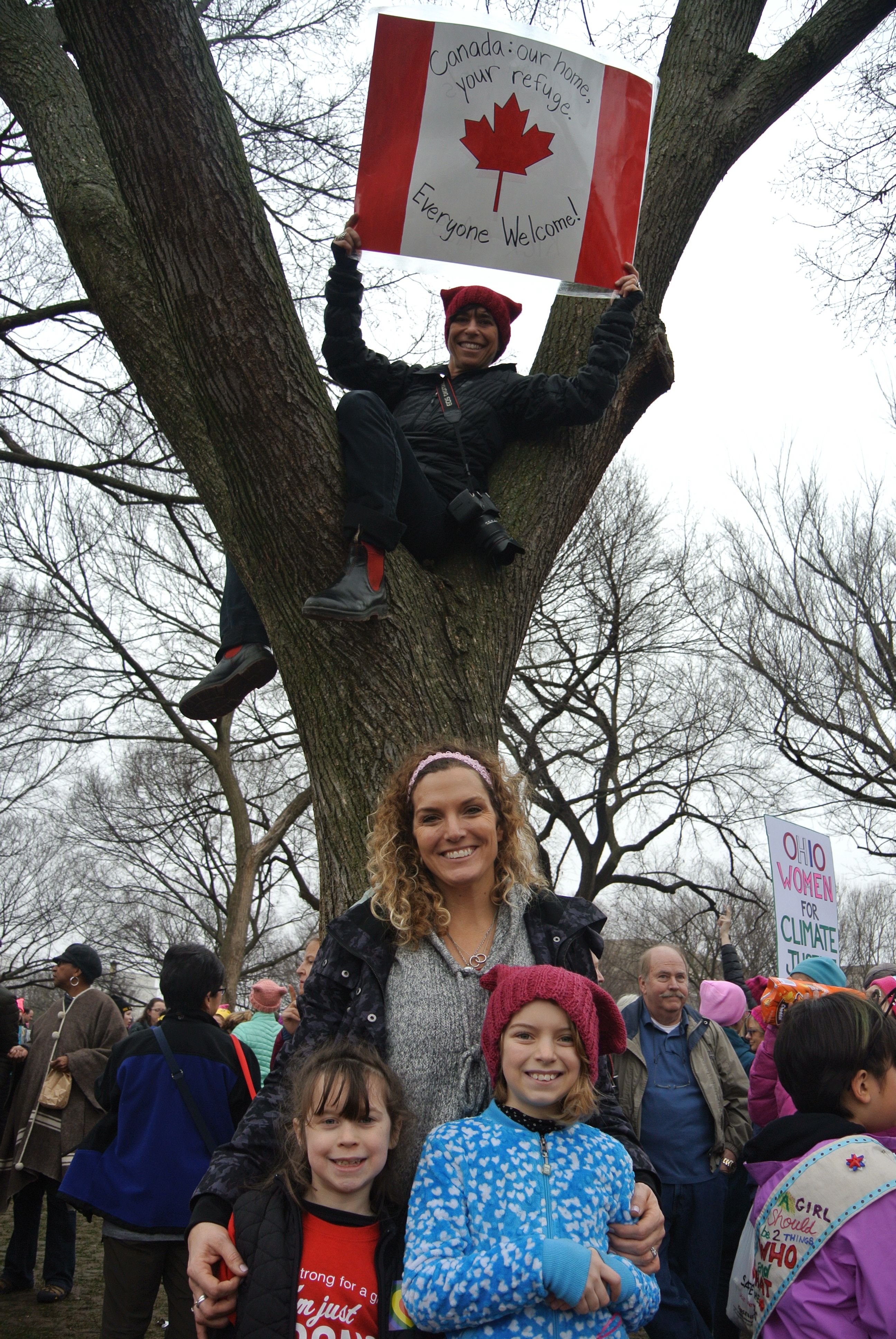
Jennifer Bascom with daughters Cameron Bascom and Mikaelle Steinberg, and partner Jessie Steinberg
Jennifer Bascom, 43
Occupation: public school teacher
Jennifer: "[We're here because] in beautiful, almost-perfect Canada, after Trump was elected there was a rise in hate crimes, including anti-Semitism, and my wife is Jewish.
"I became a feminist back in the early 90s at Queen's University, and I've sort of been protesting ever since. But it's actually been years since we went to a really big march, and I wanted to register my protest. And I wanted our daughters to experience the power of a movement of this nature, and the power of sisterhood and solidarity. And I wanted Americans to know that they're not alone, and their neighbours are not just nice, we're ready to mobilize and support them.
"I think when the people who support Trump and his values—if you can call them values—see this kind of grassroots outpouring and mobilization of thousands and hundreds of thousands of people, it will let them know that maybe their ideas are not as popular as they think they are."

Kathryn Kuitenbrouwer, 51
Occupation: teacher, novelist
Kathryn: "I'm marching with my American sisters as a show of solidarity in a time when women's rights—rights hard won over many decades—are being eroded. I am marching in solidarity with women of colour, with LGBTQ2 friends, with persons with disabilities, with immigrants, with any person who is disenfranchised or is threatened by neo-fascistic policies that may come into play with this new government.
"I imagine this march will have a mobilizing impact for many people. It already has. Just this morning on the news we heard that while 200 buses have applied for city parking in DC for inauguration day. 1,200 have applied for city parking for the march date. [Note: those numbers grew to 450 and 1,800, respectively ]. This is an astonishing, isn't it? I find it hugely exciting. Event the penguins in Antarctica will be marching!"
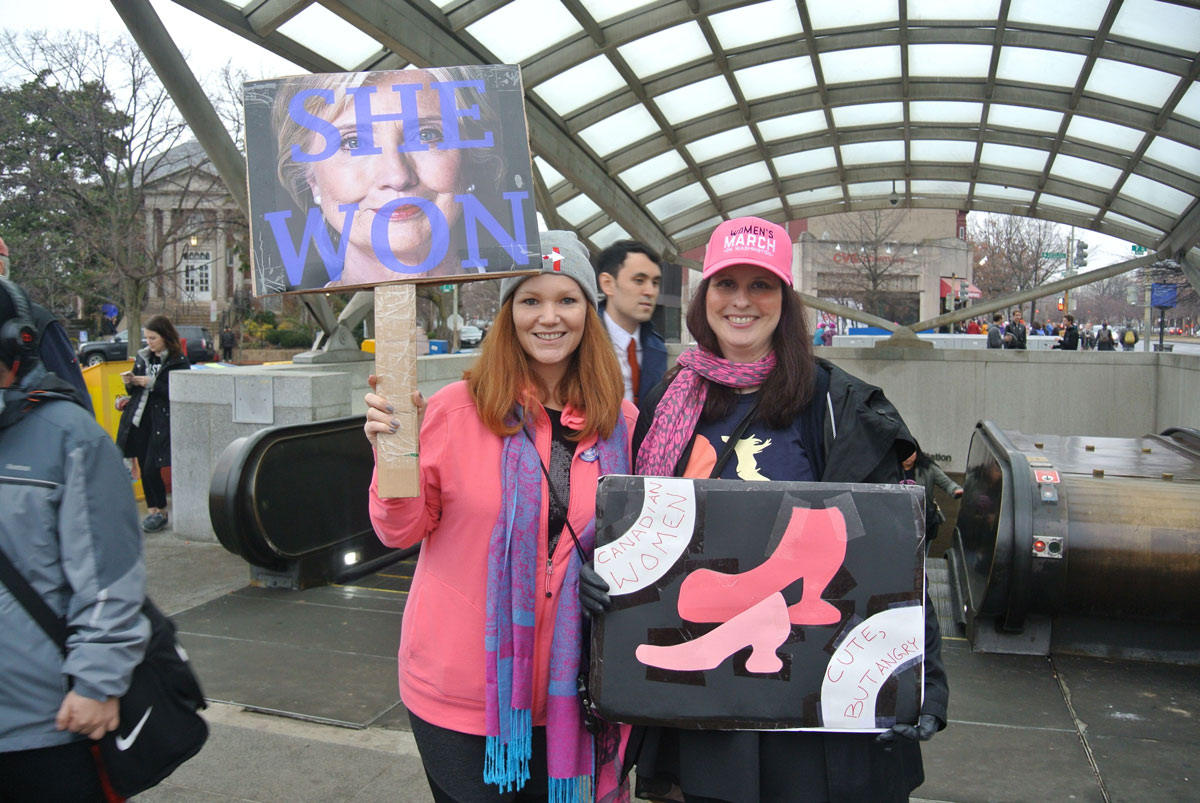
Emma Maris (left) with friend Soibhan McClelland
Emma Maris, 41
Occupation: lawyer
"Why am I participating? Oh my God, I'm going to cry!
"Because it crossed a line… things that should have been deal breakers weren't deal breakers. The gendered nature of the attacks on Hillary Clinton in particular—the criticisms that she faced that weren't faced by her male counterparts—appalled me. Every woman that came forward and said she was assaulted and they were demeaned, and said they weren't even attractive enough to assault—it hurt, and it felt personal.
"And I'm afraid it's going to spread, and we're here because they're our family, they're our neighbours, what they do affects us. And I can't stand by, it's not okay. It's not okay and he needs to hear that loud and clear. It's not okay."
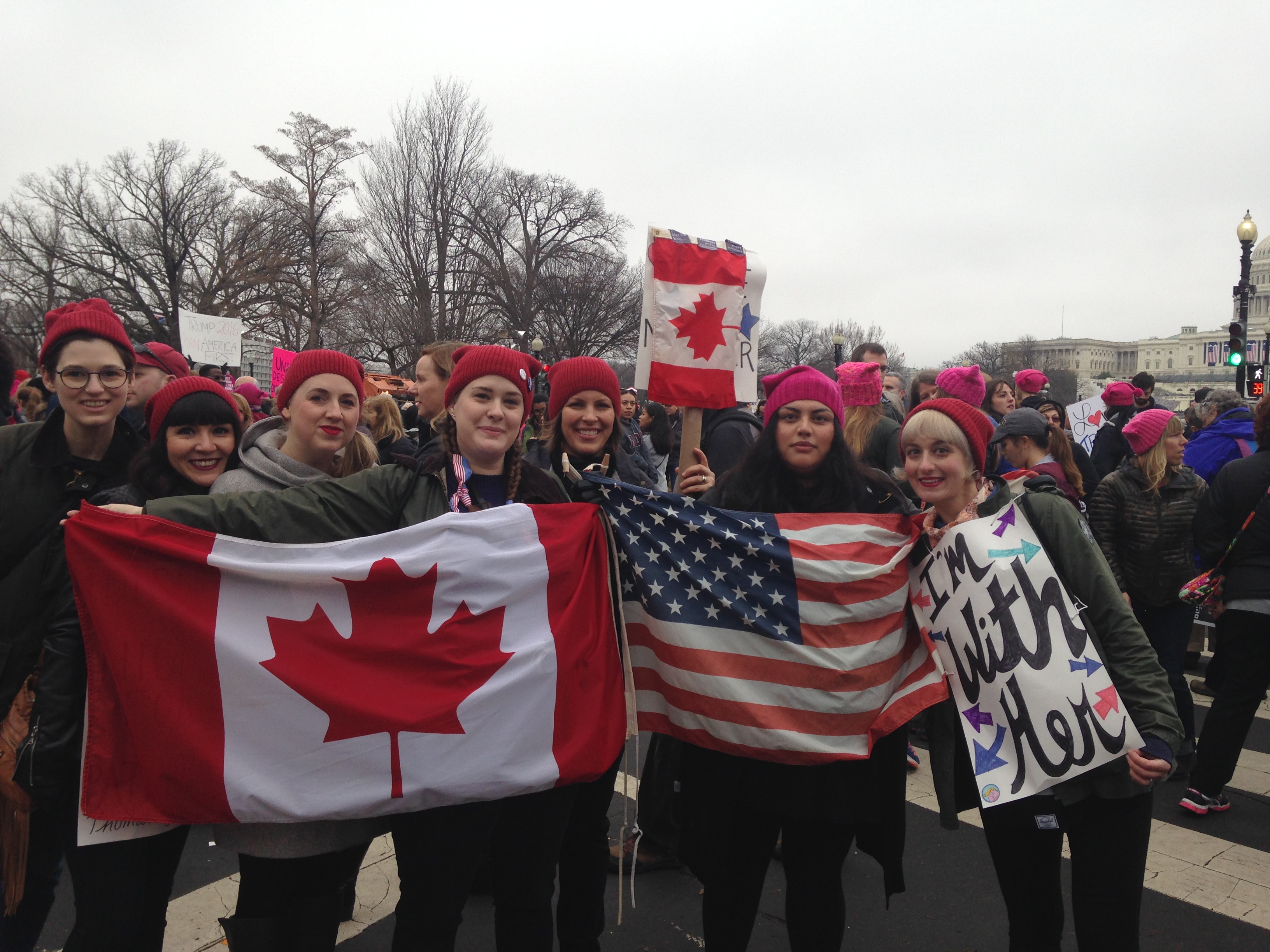
The march was too large to take the planned route, so my Canadian friends and I took our own path. We marched from the Capitol steps down the National Mall and around the Washington Monument and the Lincoln Memorial, and I watched their faces as they took it all in.
"Look what happens when women decide to organize," Carolyn said, marvelling.
"I was so angry and sick, but this kind of restores your faith," Jenn added. "There are so many of us."
Later that night over glasses of wine, we rejoiced in the massive turnout across the United States and in other countries. Laura, a mother of two and high school counsellor from Etobicoke, was impressed with the size of the march in Toronto. "I could have stayed to Toronto. I thought I had to go to DC. But I think I underestimated my sisters. I wasn't alone in my nausea."
I asked her, then, was the trip worth it?
"One hundred percent. It was breathtaking. I think it was the best day of my life."
Rosemary McManus is a teacher based in Toronto.


















